 davetansley
2 months ago
•
100%
davetansley
2 months ago
•
100%
I did try running Plasma on Mint, but it was never quite as good as on Fedora or as smooth on Mint as Cinnamon.
Honestly, I think I just like the simple uniformity of Cinnamon. It's dull and predicable, but really, really solid.
 davetansley
2 months ago
•
100%
davetansley
2 months ago
•
100%
Switched to Linux Mint about three years ago after being unable to take my perfectly good laptop from W10 to W11. Dual boot firstly, quickly becoming entirely Mint. It just worked. It was the first Linux distro I'd tried in about 20 years that I didn't mess up in a week or so.
Recently bought a new laptop and decided to distro hop. Tried various flavours of Fedora, and a few others, but ultimately came back to Mint. None of the others worked quite as well as Mint does for me (though I really liked KDE Plasma, and Gnome surprised me once I finally discovered extensions!)
 davetansley
2 months ago
•
100%
davetansley
2 months ago
•
100%
For some reason, Mint doesn't provide access to the power profiles out of the box... no idea why. I just install a Cinnamon applet called "Power Profiles" and it gives me the same systray switcher as Fedora.
Fresh install of Mint was giving me about 2 hours battery life. By switching to Power Saver profile, I can get up to about 6-8 hours. I mostly only need to go to Balanced or Performance when gaming.
 davetansley
4 months ago
•
100%
davetansley
4 months ago
•
100%
No idea if it's related, but I see similar behaviour (the not loading, rather than the error message) whenever Firefox requires a restart for an update. It doesn't make it clear this is what is happening, it just stops loading web pages in existing tabs. Only if I open a new tab does it show the "Restart to keep using" message.
I've spent far too much time diagnosing network issues without realising I just needed a restart :)
 davetansley
6 months ago
•
100%
davetansley
6 months ago
•
100%
Threads. We were shown it at school, about 12 or 13, told we should see it because it might happen. Didn't sleep a full night after that until 2005.
 davetansley
7 months ago
•
91%
davetansley
7 months ago
•
91%
I'm starting to think that we need to see AI research in the same way we see biological weapon research - a visit from a SEAL team or a cruise missile for any identified laboratory. Smash the disks, burn all the print outs!
Okay, this is hyperbolic and unrealistic, but I agree with this lion-maned YouTuber - we are really not ready.
AI as a tech is game changing, but it practically demands at least UBI (and probably some form of socialism) as a prerequisite. We, meanwhile, are still electing conservative governments! The same arseholes that will label the legions of unemployed artists, actors, musicians, coders, admin assistants etc etc as lazy and cut their benefits.
Does anyone truly believe that a tech that can replace half of human jobs is going to create happy outcomes in today's society? Or will it just make tech-bros and scammers richer, and virtually everyone else poorer?
 davetansley
8 months ago
•
100%
davetansley
8 months ago
•
100%
Working from home has its pros and cons. Fortunately, in my experience, the pros are all mine and the cons are all someone else's. That kind of colours my judgement.
 davetansley
8 months ago
•
90%
davetansley
8 months ago
•
90%
Religion has certain self-reinforcing properties. Kind of like genes that make it more likely to propagate against other forms of information.
- Believing without question is better than questioning
- Not believing will be punished
- Virtue will be rewarded
- Spreading the belief is a virtue
- You should obey your parents
Combine that with young human brains being malleable, and religion tends to continue against all odds.
 davetansley
9 months ago
•
100%
davetansley
9 months ago
•
100%
In the North East of England, the North York Moors.
 davetansley
9 months ago
•
100%
davetansley
9 months ago
•
100%
Clowns who think like this need to fuck all the way off... and, honestly, it's up to older folk like me to make that clear. Younger folks are going to be fooled or scared into thinking like this and be unable or unwilling to speak up. We who have less pressing concerns need to have their backs.
 davetansley
11 months ago
•
100%
davetansley
11 months ago
•
100%
North Yorkshire, in the UK.
 davetansley
11 months ago
•
100%
davetansley
11 months ago
•
100%
That and the woke mind virus.
 davetansley
11 months ago
•
100%
davetansley
11 months ago
•
100%
I believe Super Ghouls n Ghosts is seen as a sequel to Ghouls n Ghosts.
 davetansley
11 months ago
•
98%
davetansley
11 months ago
•
98%
Why did its valuation tank after Elon Musk took over and started enacting his policies? Perhaps we'll never know...
 davetansley
11 months ago
•
100%
davetansley
11 months ago
•
100%
Hah! I'd never seen that before! I don't think it looks too bad :)
I've certainly seen worse Amiga ports!

Just in time for the spookiest time of year, a game that features not just ghouls, but also ghosts as well. And spooky haunted turtles. Ghouls 'n Ghosts (Dai Makaimura in Japan) is a classic 1988 Capcom arcade game and sequel to the highly popular Ghosts 'n Goblins. Like its predecessor, you play Arthur, a knight who must save a princess by battling through six spook-filled levels. Along the way, you collect a variety of weapons (sometimes against your will!), beat bosses, avoid wizards in chests, and generally work your way from left to right. You get two hits per life, with your armour disappearing after the first. To help you out, you can collect a golden set of armour that has a charge attack, but you seldom get a chance to use it.  The arcade original is just gorgeous in every respect, with masterful pixel art graphics, music that is both spooky and catchy, and controls that feel fluid and responsive. Its levels are varied and interesting, and its bosses challenging. In fact, the whole game is a challenge, with the difficulty ramping right up from the end of level 1. You're never given a moment to breathe, as zombies continually spill out of the ground and attack you. Gotta keep those quarters coming! And if you pick up the wrong weapon (basically anything but the knife), you're stuck with it, unless you chance upon a better pick up. The game was ported all over the place, with varying degrees of success. It came towards the end of the life of the 8-bit micros, so hopes wouldn't have been high... so how did they do? Actually, not bad. Let's take a look.  There's not a lot to pick between the 8-bit and 16-bit micro versions, with each of them suffering similar problems, the worst of which is the limitations of a single-button joystick. This means that firing upwards (an essential part of some levels) is combined with an initial jump, causing you to jump into the enemy you're trying to dispatch! The Amstrad suffers all of this, but also some pretty gross push scrolling, which makes it difficult to avoid some enemies. It otherwise looks okay, I guess, with colourful, distinct graphics. It controls fairly well, despite the scrolling limitations, but it is definitely the hardest of the three 8-bit micros. Sound is pretty much non-existent in-game, but it has a lovely title screen rendition of the Ghouls 'n Ghosts theme. Shame it couldn't play in-game. Not a bad effort, if a little clunky.  The C64 version is distinct from the Amstrad and Spectrum, as is fairly common with games from this era. It has much smaller graphics, but some lovely smooth scrolling. Some of its levels feel incredibly sparse, with very few enemies, which makes it a lot easier than the Amstrad version. Unlike other 8-bit versions, the C64 version has in-game music... though, inexplicably, opts for a custom theme rather than the very familiar Ghouls 'n Ghosts music. It's very good, but also feels very out of place...  I start a lot of these Spectrum sections with "you'll have to trust me on this...", and this game is no exception. The Spectrum version shares a lot in common with the Amstrad version, but the overall package is a lot slicker. The scrolling is smooth (at least for a Spectrum), the sound is better, and the control feels fluid and "right". This version, of the three 8-bit micros, feels the most like the arcade. That said, it looks very basic, and is certainly the worst looking of the three, with monochrome graphics that feel sparse and bland. But what did you expect? Not a bad effort though, and well worth a look for those interested in seeing this ancient machine pushed to its limits. You just need to squint a little...  Sigh. There's just something deeply disappointing about playing Amiga arcade ports from this era. It's how a teacher must feel when an obviously gifted student just phones it in and scrapes a D. Amiga Ghouls 'n Ghosts is that kind of port... It looks kind of okay in stills, but when it moves it reveals itself. Slow, jerky scrolling. Lacklustre colours. A small playfield... Like the C64, it goes its own way for music on level 1, and while the tune is suitably spooky, it just never seems to get going. Overall, its not a terrible port. Its certainly playable. Its just... the Amiga could do so much more, you know?  Over on the consoles, things were a lot better. Starting with the most basic conversion, that of the Sega Master System, we begin to see a lot more of the original's DNA. The music is here in-game, a plinky plinky chip tune rendition of the original that is perfectly serviceable. The graphics are good and colourful, if a little blocky. It plays really well, and even adds in some light RPG elements in the form of shops in which you can upgrade your equipment. Not sure why this version alone got that addition, but it certainly adds depth. Overall, I think you'd be happy with this if you were a Master System owner in the late 80s.  Over on the Master System's big brother, we have perhaps the most impressive port of all (though not the most accurate). Programmed by Yuji Naka (of Sonic The Hedgehog fame), the Megadrive port is extremely competent. Everything is here and incredibly faithful to the original. The music is amazing, managing to sound both faithful and unmistakably Megadrive. The graphics are on point, with just a slightly gaudy palette letting it down slightly. Best of all, it plays incredibly well. If you want to experience just one "interpretative" port (rather than one of the identical or emulated ports), give this a go.  A rare spawn - a Supergrafx version! This little known successor to the PC Engine got very few games, and Ghouls 'n Ghosts was perhaps the most famous. Like the Megadrive, it's a highly faithful and very impressive conversion. Its graphics are perhaps a little more detailed than the Megadrive, with a more refined palette that can sometimes look a little drab. Still, it's a brilliant conversion, and well worth a look (if you can track it down!)  Onto the Sharp X68000 "port"... It's hard to know what to do with this version (and the Playstation one), since they don't hit the same curiosity triggers as, say, the Amstrad version. It doesn't really feel like a conversion at all, it feels exactly like the arcade game. And with good reason... the X68000 shared a lot of hardware similarities with the arcade games of the time, and was even used by Capcom as the CPS development machine. So of course it feels great. But we're here to see the brave leaps of faith and the tragic failures of ambition... and this ain't that. Still, if you want to see a truly arcade perfect port of Ghouls 'n Ghosts, have a look at this...  ... Or this. The PlayStation version is, presumably, using some kind of emulation and a dump of the arcade ROM. As such, I'm tempted to disqualify it... but I wanted to include it purely to point out that even this method doesn't always guarantee perfection. There's something busted about the brightness in this version. It's way too dark. For my screenshots above, I've had to give it a bit of a crank up a notch or two - unscientific, yeah, but otherwise it was very hard to see anything! It could be a problem with my MiSTer, but the few YouTube videos I've seen suggest the same problem... So there you have it. Ghouls 'n Ghosts, a cool game wherever you play it, and a very hard one at that. Try the Megadrive/Genesis port, if you can try just one. Happy Halloween! 🎃
 davetansley
11 months ago
•
100%
davetansley
11 months ago
•
100%
If, like me, you do a lot of Chromecasting from your browser, you'll want to install fx_cast. You need to do a bit of manual installation to get it running, but it works great when you do.
 davetansley
11 months ago
•
100%
davetansley
11 months ago
•
100%
They 100% count!

I'm not normally one for themed, seasonal gaming... but Halloween seems to lend itself particularly well to playing a particular type of game. So what are you playing this spooky season? This year, I'm playing through Castlevania: Dawn of Sorrow (DS version, via the Retroid Pocket 2S). It's not the spookiest entry in the series, but has enough creepy castle exploration to fit the bill.
 davetansley
11 months ago
•
100%
davetansley
11 months ago
•
100%
Dwarf Fortress is one of those games that I love to read about, but I don't think I would actually enjoy playing. Like Eve Online.
 davetansley
11 months ago
•
100%
davetansley
11 months ago
•
100%
Nope, it's Zelda 3 on the SNES.
 davetansley
11 months ago
•
100%
davetansley
11 months ago
•
100%
My heart says it should be Dark Souls, but my head reminds me I absolutely hated it until I'd figured out that the run from Undead Burg bonfire to Taurus Demon couldn't be rushed, and the point of the game was to be slow and methodical. Then I loved it.
 davetansley
11 months ago
•
100%
davetansley
11 months ago
•
100%
I love and hate the feeling in Animal Crossing that the world has just continued existing without you for the last 18 months that you haven't booted it up. Feels like visiting old friends... but old friends that thought you were dead or something.
 davetansley
11 months ago
•
92%
davetansley
11 months ago
•
92%
Yeah, it really was amazing to play blind. We especially enjoyed the DLC... when we first realised what it was all about, it nearly blew our minds!
 davetansley
11 months ago
•
100%
davetansley
11 months ago
•
100%
It does seem to have been overshadowed by Shadow of the Colossus somewhat.
 davetansley
11 months ago
•
100%
davetansley
11 months ago
•
100%
I picked it up blind after getting carried away in the magazine hype and excitement. I'd not played any FF games before that... man, that was quite an experience!
 davetansley
11 months ago
•
100%
davetansley
11 months ago
•
100%
It's 20 years old... if Windwaker isn't considered retro now, then Atari 2600 games weren't considered retro in 1997 :)

(Saw this question asked on another popular link aggregation website and it got me thinking) If you could play one game for the first time all over again, what would you choose? This might be because you want to do it all again, or because you don't think you got enough out of it the first time. It could be experiencing the game exactly as you were back then, or experiencing a game with what you know now. For me, it's Legend of Zelda: A Link To The Past, experienced exactly as I was back in 1991. Nothing comes close to how jaw-droppingly amazed I was by that opening sequence. The epic orchestral score, the cinematic rainstorm, creeping around in the dark... it was a generational leap above anything I'd played on 8-bit computers and consoles, and even the Megadrive. I'd love to play it again without thirty plus years of Nintendo/Zelda knowledge, or without knowing about the dark world.
 davetansley
12 months ago
•
100%
davetansley
12 months ago
•
100%
Pretty much all of them... I have so many memories of old 80s computer games where all I remember is level 1. It appears that I was terrible and perfectly happy with that.
 davetansley
1 year ago
•
100%
davetansley
1 year ago
•
100%
Difficult...
- Lamb Lies Down on Broadway - Genesis
- Misplaced Childhood - Marillion
- Prequelle - Ghost
- Oh, Inverted World - The Shins
- Ten - Pearl Jam
- Tubular Bells II - Mike Oldfield
- Vast - Vast
- English Settlement - XTC
- The Friends of Mr Cairo - Jon and Vangelis
- Appetite For Destruction - Guns n Roses
 davetansley
1 year ago
•
100%
davetansley
1 year ago
•
100%
I don't have the other devices to compare, but I understands that it should handle those platforms better than the 2+ and slightly worse than the 3+. So some playable games, but not all.
I tried a few GC games (Mario Kart Double Dash and Monkey Ball). They seemed to run okay. Monkey Ball ran worse than Mario Kart.
 davetansley
1 year ago
•
100%
davetansley
1 year ago
•
100%
More powerful chipset and different dpad/left stick placement is the main one. Here's a breakdown:
https://retroabxy.com/retroid-pocket-2-plus-vs-retroid-pocket-2s/
 davetansley
1 year ago
•
100%
davetansley
1 year ago
•
100%
Yeah, it's confusing, and not helped by the fact that they release a new one every couple of months.
 davetansley
1 year ago
•
100%
davetansley
1 year ago
•
100%
Funnily enough, that's one of the reasons I went with the 2S over the 3+. I love the look of the old NGPC!

cross-posted from: https://lemmy.world/post/4790038 > I got the new Retroid Pocket 2S in clear black. It worked out about 105 quid delivered, and took just over a week to arrive. > > It's a lovely little device, with some really nice sticks and triggers. But it really hammered home how easy it is to set up a Miyoo Mini Plus (which was largely just a case of copying over the ROMs). This one comes pretty much barebones, and it's up to you to install all the emus and a decent front end. So you end up with a weird combination of Retroarch and stand alone emus, and a confusing set of different configs. Retroarch alone is an absolute beast to understand and get right...it seems to have a slippery complexity that is very difficult to hold in your brain. > > That said, once it's set up, it is lovely. I'm using Daijisho as a front end, and it pretty much hides all the underlying complications. 4:3 systems look great on the tiny screen, and it runs up to Dreamcast really well, with some GC games running nicely. The only downside is that the PSP's 16:9 screen looks a little titchy letter-boxed on the screen, but it's a small price to pay for portable Outrun 2. > > Overall, very impressed... though concerned that this is my second retro handheld and I'm already thinking about things that would make me pick up a third. These things are compelling, eh?

I got the new Retroid Pocket 2S in clear black. It worked out about 105 quid delivered, and took just over a week to arrive. It's a lovely little device, with some really nice sticks and triggers. But it really hammered home how easy it is to set up a Miyoo Mini Plus (which was largely just a case of copying over the ROMs). This one comes pretty much barebones, and it's up to you to install all the emus and a decent front end. So you end up with a weird combination of Retroarch and stand alone emus, and a confusing set of different configs. Retroarch alone is an absolute beast to understand and get right...it seems to have a slippery complexity that is very difficult to hold in your brain. That said, once it's set up, it is lovely. I'm using Daijisho as a front end, and it pretty much hides all the underlying complications. 4:3 systems look great on the tiny screen, and it runs up to Dreamcast really well, with some GC games running nicely. The only downside is that the PSP's 16:9 screen looks a little titchy letter-boxed on the screen, but it's a small price to pay for portable Outrun 2. Overall, very impressed... though concerned that this is my second retro handheld and I'm already thinking about things that would make me pick up a third. These things are compelling, eh?

For me it was 2000AD 690. Picked it up on a whim as a 15 year old on begrudging holiday with my family. It was bang in the middle of the Necropolis story, and everything about it seemed fascinating to me... It caused me to collect both forwards and backwards, desperate to know what had happened before (which was a lot, since this storyline had been brewing for years) and what happened after. It was also a gateway drug into US comics, primarily Marvel, but pretty much anything that looked cool at the time. I still have all my physical books, stored in a bunch of long boxes up in the attic that I swear I'll get down and look at one day, but never do... Which issue was your gateway drug?
 davetansley
1 year ago
•
90%
davetansley
1 year ago
•
90%
Yep. Even when clicking the single checkbox captchas, I try really hard to click it "just like a human would". Which is weird, because I am a human. I think.
 davetansley
1 year ago
•
100%
davetansley
1 year ago
•
100%
I had a similar need, and it prevented me from moving to FireFox for a long while. Luckily, I did manage to get fx_cast to work, and it's been flawless ever since. In fact, I'd say it work more reliably than Chrome's casting!
 davetansley
1 year ago
•
100%
davetansley
1 year ago
•
100%
Except in the case of the Sega Master System, where the simplistic 8-bit graphics felt like a massive leap up from the terrible box art!

 davetansley
1 year ago
•
100%
davetansley
1 year ago
•
100%
Often it was because the ports were given to different companies to do... one would get the Spectrum/Amstrad and another would get the C64. Also, the whole sound and graphics systems would need to be rewritten, given the Spectrum's lack of hardware sprites or scrolling, or decent sound. Presumably it just made sense to build them separately.
 davetansley
1 year ago
•
100%
davetansley
1 year ago
•
100%
Can't believe I missed that one! Sounds like it made some interesting compromises.
 davetansley
1 year ago
•
100%
davetansley
1 year ago
•
100%
I always thought that as well, and was similarly jealous. But in doing these port comparisons, I've found that the C64 often got a really bad port. See my Bomb Jack post the other day, for example.
If you can look past the visuals and sound, the Spectrum ports often capture the feel of the arcade the best of all. It's probably about 45-45-10 (C64-Speccy-Amstrad), with the Amstrad getting some rare gems like Renegade.
 davetansley
1 year ago
•
100%
davetansley
1 year ago
•
100%
I'm not sure that's the case...
A lot of the time, the C64 and Spectrum/Amstrad ports were done by different companies, in isolation. You'd often see the C64 go its own way, changing up levels and gameplay. While the Amstrad port was usually a lazy port of the Spectrum. You can often see the colour limitations of the Spectrum ported across wholesale to the Amstrad as well.
In the case of Commando, the Spectrum and Amstrad teams had some overlap and the games share some of the same DNA (see the title screen, for example), while the C64 was distinct. It doesn't feel like a lazy Spectrum > Amstrad port though, so it has that going for it. The C64, as usual, feels like its own thing.

Commando (released as Senjō no Ōkami in Japan, Wolf of the Battlefield) is a 1985 Capcom arcade shooter. Word to the wise: Commando isn't based on the Schwarzenegger movie of the same name - that's some false knowledge I've carried round with me for close to forty years... oh, how I've embarrassed myself at dinner parties...  Commando is a vertically scrolling run-and-gun shooter where you play "Super Joe", a one-man army pitted against the endless ravenous hordes of whatever country was the mid-80s enemy du jour at the time. You have a gun with unlimited ammo, and a finite supply of grenades with which to dispatch your foes. While the gun can fire in any direction, the grenades only launch upwards, which creates a need for careful positioning in order to use them effectively. The game is split into levels, and each level ends with a heavily fortified building that spews out a huge number of enemies that must be defeated before you progress. It's a cool game, one of the first of its kind. It's also fast and frantic, and doesn't really reward slow and methodical play. You've almost got to treat it as an auto-scroller, never slowing down, just moving forward and spraying your gun wherever you can. If you don't, you risk being overwhelmed by the constantly respawning bad guys. It was a genre defining title, spawning many imitators (such as Ikari Warriors, the home Rambo games, and countless others; as well as a 198 sequel, Mercs). It was also extremely tough, especially the unforgiving end-of-level sequences. A real coin muncher. In terms of ports, it got more conversions than a corrupt third-world regime has cannon fodder mercenaries. And I've looked at them all... war is hell, man. So, lock and load, we've got a lot to get through...  We begin this epic journey with a familiar friend: the Amstrad. But it's not up here because it's terrible, far from it. It's actually a pretty decent conversion, albeit not as good as the Spectrum or C64. Like the Spectrum, it suffers a bit from its one-button joystick, meaning that grenades are fired by holding down the button, which leaves you a little vulnerable for a moment. I think I prefer the C64's approach of using the space bar for this. The graphics are bold and clear, if a little monotonous; the game is hard, but fair; and the sound is... okay. Overall, it's fine. Not the best, not the worst.  The Spectrum port of Commando is good, seriously. It just looks bloody awful. Not sure why they chose yellow as the background colour, but they did and you end up feeling like you're wading in custard. It's not the only port to feel like this. If you can ignore the stinky visuals, there's a great game underneath. It is fast, similar in pace to the arcade and has a similar frantic feeling. It throws hordes of enemies at you, just like the arcade... no idea how the Spectrum keeps up! Bullets are very visible, making it feel fair, even the sound is okay. Overall, a great effort!  I think C64 owners would claim Commando as their very own, and with good reason. It's very much a C64 staple. It's the theme music, you see? A Rob Hubbard classic, famously knocked up in 12 hours. And it's great! But beyond the awesome SID soundtrack, the game is amazing as well. Smooth, fluid, fair, fast, it just feels right. On the 8-bit micros, at least, it is the closest by far to the arcade. You could, perhaps, argue that it is a little bit... brown. But hey, so was the original. And it worked for literally every Xbox 360 game, so I'm prepared to let it slide. Well worth a look, even today!  We leave the well-trod paths of 8-bit machines and enter the hinterlands... The BBC Micro, for those not raised in the UK in the 80s, was a machine that was only ever owned by the children of geography teachers. It was never meant to be a games machine, it was meant to be for learning or a tool for recreating the Doomsday book (don't ask). Nevertheless, it turned in a commendable effort on its Commando homework, a solid B-. Yet another victim of the yellow backdrop curse, this effort is garish and bright. It is also pretty slow, with jerky movement. That limitation kind of changes how you play the game. It becomes more intentional, less frantic. You can take your time a little, plot out the best place to stand and fight. In that respect, it's quite enjoyable. So a reasonable effort, if a little... yellow.  Sadly, the same can't be said about the MSX version, which isn't so much a war hero, as a war crime. It looks passable in still form, with colourful graphics that are reminiscent of the arcade. It has that old MSX thing of a multi-colour main sprite and monochrome enemies, but looks mostly fine. Sadly, it all comes apart when it moves... the main sprite jerks from character block to character block, the screen moves similarly badly. It's like viewing Commando through a flashing strobe light. The music is discordant and jarring, and plays in half-hearted 20 second bursts before giving up. Really off-putting. It's a shame, because it has all the elements of the arcade in one form or another. They're just put together in such a way that makes playing it feel like having a seizure.  Enough with the garish 8-bit ports, let's take a look at what the 16-bit powerhouses can do... The Amiga turns in a solid effort. Pretty boring really, leaving me very little to comment on. It's Commando... slick, smooth graphics, solid controls, a nice rendition of the arcade music. It's enjoyable to play, but doesn't really push any limits... If you want solid, authentic competency, this is the port for you. But where's the fun in that?  Similar to the Amiga version, the Atari ST phones in another competent port. In fact, I actually prefer this version to the Amiga version. It feels looser, smoother, a bit faster maybe? Regardless, there's not much in it, with both versions having near identical graphics. The ST music is a bit chippier, but it still sounds authentic. Another great port!  Regular readers of these posts will know that what I value more than lazily applied raw power, is *moxie*. And this port has moxie in spades. It's an Intellivision, for goodness sake! From 1979! It has 1K of RAM! This machine has no business running a game like Commando... and yet... Okay, it doesn't look much like the original, with the chunky colourful sprites being whittled back to one colour stick men. But it moves kinda like Commando and it sounds kinda like Commando and it plays kinda like Commando. All of it powered by sheer moxie alone! It's not the best port here by a long way, but it is perhaps the most impressive. Importantly, it's also very playable, enjoyable even! It has *moxie*, see?  Now, there's moxie and there's wishful thinking, and the Atari 2600 (hailing from 1977) was more of the latter and less of the former. If the Intellivision port embodies the spirit of Commando, the Atari 2600 embodies the spirit of a two sentence description of Commando. It is super basic, super stripped back, and it doesn't really work, sadly. The graphics are limited, with yet more liberal use of yellow; the movement is perfunctory; the bullets frequently go missing and can't be avoided, and it's annoying to play rather than quirky. There are good 2600 games, games that are enjoyable even today, but this isn't one of them. Well, what do you expect? The console is basically just resistors!  Luckily for Atari console fans, the Atari 7800 version is actually quite good. It's a proper grown-up console version, comparable to the NES port, and very playable. It has all the bits and pieces from the arcade, and adds pick-ups to give you a more powerful gun, or a knife to enable hand to hand killing (run into enemies). It looks great and moves smoothly and, if you're playing the original cartridge, it uses an extra POKEY chip to give enhanced sound (one of only two 7800 games to do so).  The NES version of Commando is probably the best of the bunch, possessing that slick console feel that leads to such great coin-op conversions. Superficially, it's a solid recreation of the arcade. It looks great, it sounds as good as can be expected, it is smooth, fast and frantic. It sometimes pushes the limits of the NES too far though, with the abundance of on-screen sprites causing some pretty epic sprite flicker. But you barely notice it in the heat of the action. Like several other NES conversions (Rygar, Strider), this one adds a number of little extras to prolong interest. It has powerups that can be collected for points or to make your weapons more powerful. Also, hidden around the levels and revealed by a well-placed grenade throw, are ladders. If you climb these ladders down, you're taken to a hidden bunker, containing either hostages, enemies or pick-ups. It doesn't add a great deal to the game, other than the need to locate these ladders, and you could even argue that it detracts from the frantic pace. But it's an interesting example of how developers tried to add a little bit extra to coin-op conversions back then. So there you have it, Commando. If you want to experience it today, try the C64 or NES versions for realsies, or the Intellivision version for interest.
 davetansley
1 year ago
•
100%
davetansley
1 year ago
•
100%
It's a cool game.
Oddly enough, the MiSTer FPGA N64 core has undergone some incredibly quick progress in the last few days, and Wave Race 64 is one of the first games that is almost fully playable. Follow the dolphin!
 davetansley
1 year ago
•
100%
davetansley
1 year ago
•
100%
I did a much smaller comparison over on Mastodon a few months back: https://mastodonapp.uk/@davetansley/109767977707445539
It's one of my favourite games from that era, so I'll maybe expand it and post here.

I feel as if I've been hanging out at the arse-end of the 80s a lot recently, comparing ports on computers that had no business running them. I've long suspected that if you want to see 8-bit micros at their best, you're better served hanging around in 1986 rather than 1989. Things were so much more achievable back then... So, with a robust tailwind of realistic expectations at our backs, let's take a look at Tehkan's 1984 arcade hit, Bomb Jack.  Bomb Jack is one of those much-loved arcade classics that everyone knows but which never quite reached the same revered status as earlier hits like Donkey Kong or Pacman. It came at that inflection point in the arcades where single-screen, high score games were being replaced by more complex, sprawling coin-munchers. A kind of last-hurrah for wonderful simplicity. And Bomb jack truly has simplicity. It is played over five backdrops, where you play "Jack", a caped superhero, who is tasked with defusing a number of bombs that are sprinkled around the level. As you begin to collect them, a single bomb's fuse will ignite. Collect this, and you get a 200 point bonus and cause another bomb to light. Getting the highest score becomes a matter of strategically collecting the fizzing bombs and avoiding the unlit bombs. Or you could just collect bombs regardless and forgo the extra points. Standing in your way is an array of bad guys, from killer robots to um... birds. But you're not entirely defenseless, as you can pick up a "P" power-up that renders all enemies vulnerable and stationary, kind of like the power pill in Pacman. Ultimately, Bomb Jack is a game about movement. Jack can jump high into the air and, with a tap of the fire button, float slowly back down to earth, enabling you to collect the higher up bombs. This requires a bit of skill to master, and you'll need to use the float mechanic to avoid the screen's enemies. To emphasise this vertical motion, Bomb Jack's cabinet comes with a 3:4, "tate" mode monitor. Overall, it's a fun, bright score-chaser game, well worth a quick look. But how did it look on the home versions?  Oof. Slipping sheepishly into the hated first slot is the C64 version, easily the worst of the bunch. There's no reason why it should be, it just feels full of unforced errors. Like how chunky everything is. The Bomb Jack sprite and the enemies are just too big. It's difficult to move, difficult to soar, difficult to sneak in for swooping bomb collection moves. It's also muddy and grim, with some backgrounds being inexplicably the same colour as the bombs. Uniquely, among the original home ports, this version has a clunky rendition of Jean-Michel Jarre's Magnetic Fields playing in the background. But not even the Synth Pop King can save it from its grizzly fate.  Listen, as an old ZX Spectrum advocate, I appreciate moxie. And the C16 version of Bomb Jack more than makes up for its technical shortcomings with a generous dollop of moxy and chutzpah. It's ambitious in a way that 16k machines shouldn't be, and for that, it merits a flamboyant doff of the cap. But for all that it plays a surprisingly okay game of Bomb Jack, it's not amazing. For a start, it cuts down the number of backdrops to one or two, with subsequent levels being rearrangements of the platforms over the same background image. It's also very grey and dark, and it suffers the same chunky-monkey shortcomings as its big brother, the C64. Still, B+ for effort.  A bad day for the Commodore brothers... While the C16 achieved a lot with precious little, the Amiga does sod all with a great deal. It feels like one of those early Amiga ports where the devs weren't quite up to speed with the powerhouse they were coding for, but it was actually released in 1988, two years after the 8-bit ports. For a game released in the middle of the Amiga's life, it plays remarkably badly. Movement is slow, laboured, stuttering. The graphics are bland. The three-bar theme music is infuriating... overall, a bad, bad port.  Sidling up alongside the Amiga version, wearing a self-satisfied smirk on its face, is the Atari ST version. Normally the sickly cousin of its 16-bit rival, the Atari ST somehow manages to win this inconsequential encounter. Its port looks virtually identical to the Amiga version, but it moves so much better. It is fast, fluid and plays largely the same as the arcade. Even the AY sound is inexplicably better. Word to the wise: By default, the ST version has "Mouse" as its initial control scheme. Yeah, I don't get it either. If you don't spot this, you may almost write it off without realising it's actually pretty good!  What's this? An Amstrad port sneaking ahead of the pack? Yep, it doesn't happen often, but the Amstrad version of Bomb Jack is actually pretty solid. It's appears to be based on the Spectrum version, but with a characteristically Amstrad-esque colour scheme (garish). It plays well, fast and fluid and with plenty of space to enjoy the soaring movement. Overall, not bad!  There's something uniquely reassuring about a console port, especially when viewed alongside home micro ports. They tend to have an extra level of polish, a feeling that the devs haven't just spent all their time working out how to get the thing to run, but also how it feels when it does run. The Gameboy port is a lot like that. It's Bomb Jack, sure enough, shrunk down, monochromed into that love-it-or-hate-it Gameboy green... but it feels so much better than the other ports. Movement is fluid, at a solid framerate. It feels more balanced. It has continues! Overall, it feels like a more modern experience. Then again, this version was released in 1992, a full 6 years after most of the 8-bit ports, and a lot of "user experience" water had passed under the bridge in that time. So for all that it is a great port, I'm going to have to mark it down slightly. Sure, it's a fun version of Bomb Jack, but why wouldn't it be? It was released in the same year as Streets of Rage 2!  Blimey! Taking the top spot, surprisingly, is the ZX Spectrum version... no, wait, hear me out... I know I come across as a bit of a Speccy apologist and, I admit, I served my time in the Platform Wars of the 80s. I've made baseless arguments about the Spectrum's capabilities that fly in the face of sense and logic at times. But, this time, I feel such hyperbole is warranted. See, Bomb Jack feels ideally suited to the Spectrum. It doesn't require any fancy scrolling, it is bright, it demands a reasonably high res screen and a fairly nimble CPU to move things around quickly. And those are things the Spectrum can do. Sure, our rubber-keyed pal opts for "any colour as long as it is black" for the sprites and platforms, but it kind of works. It lets the backdrops be outrageously colourful, just like the arcade. And it plays well too, moving just like the original, or so it seems to me. It feels right in a way that the Amiga and C64 ports don't. Even the humble 48k sound isn't terrible... bleeps and bloops and warbling jumps. I don't say this often, but if you're going to play a port of Bomb Jack, you should definitely check out the Spectrum version...

cross-posted from: https://lemmy.world/post/1312535 > Some games arrive right on time, while some games arrive later than they should... but some, a rare few, arrive way too early. Like Micronaut One. > > 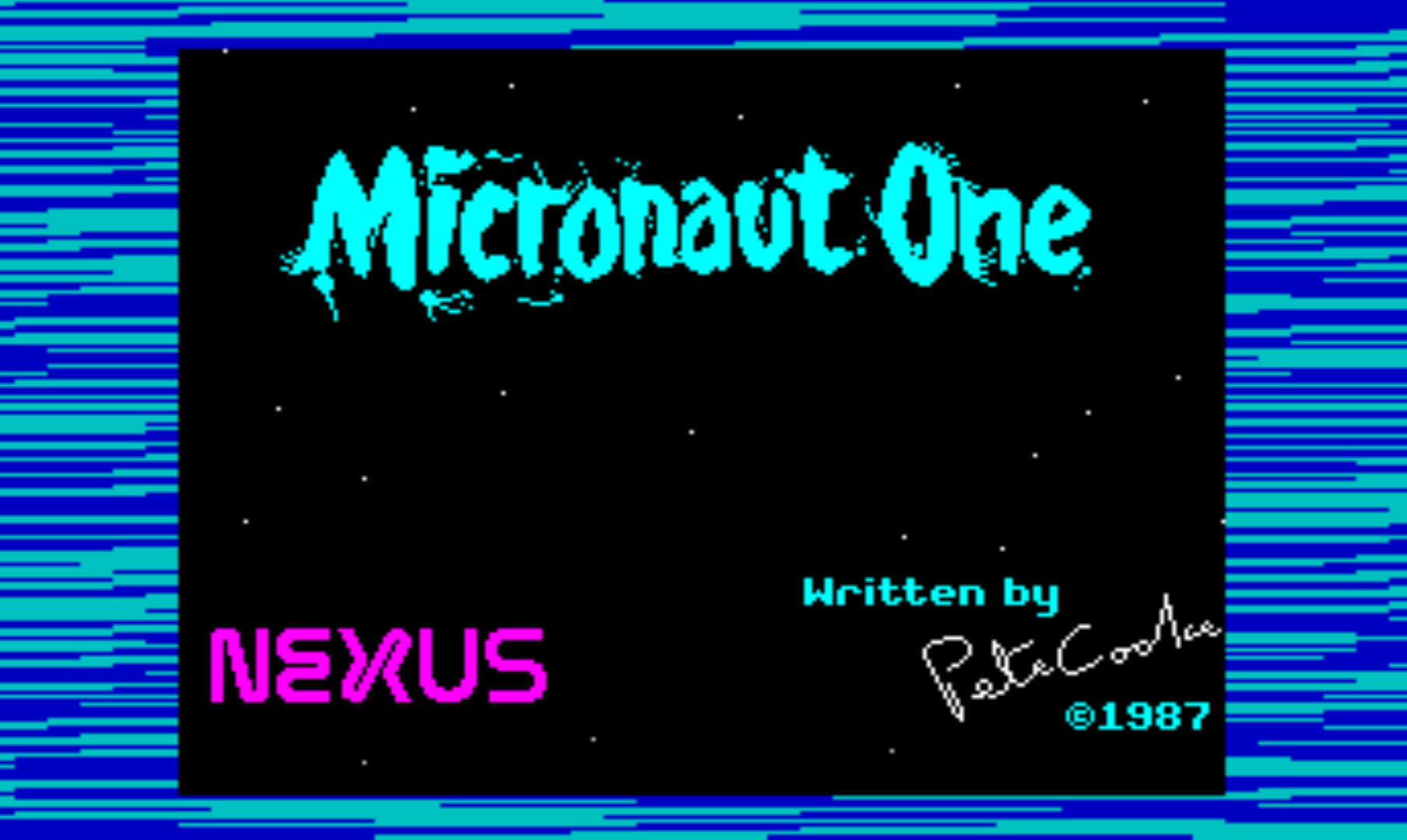 > > You've probably never heard of Micronaut One, and with good reason. It was a single platform, 1987 title that was released with little fanfare and to modest acclaim, on a platform largely only popular in Europe. It wasn't a sequel itself, nor did it generate a sequel or a franchise. It simply arrived, enjoyed a moment in the sun, then disappeared... > > To my mind, this is a great shame. Not because Micronaut One was an amazing game (it was more technically intriguing, in my opinion, than amazingly playable), but because Micronaut One was so far ahead of its time that it deserves to be more widely known. > > Even without digging into the finer details, Micronaut One sounds surface-level impressive. It is a first-person, solid 3D science fiction game, on the ZX Spectrum, of all things. In it, you pilot a craft around the winding, intersecting corridors of some great ship, manipulating the energy levels of various computer nodes in an effort to stop an overload. > > As you travel around, you encounter various fauna that inhabit the ship with you. These mostly take the form of "Scrim", an insect lifeform with a three stage growth cycle - from invulnerable eggs, to creeping larvae, to egg-laying flies. > > If you fail to destroy these creatures, they inevitably mature and start forming webs that block the corridors. Eventually, you'll find your route between the overloading nodes is impossible, and overload will be imminent... > > 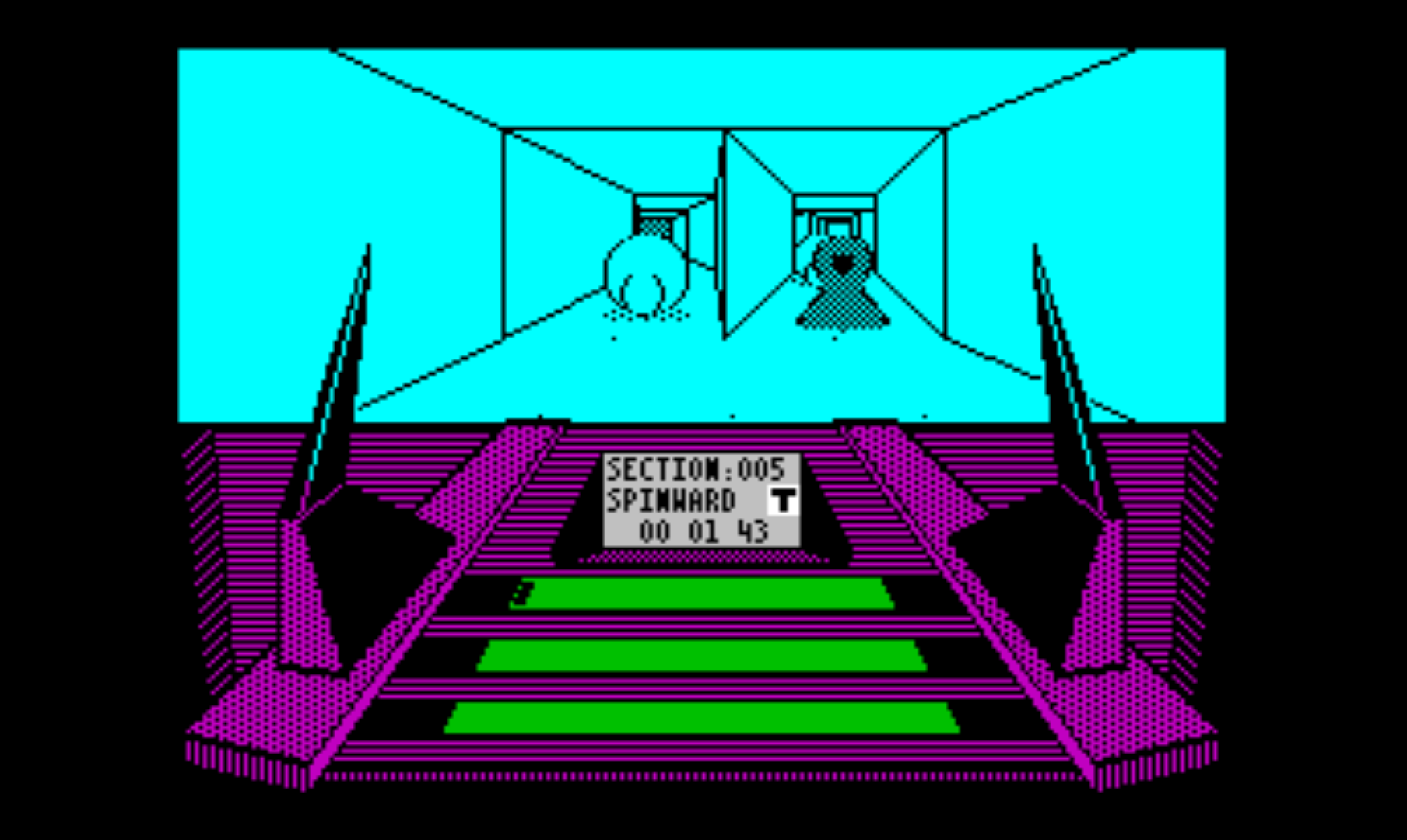 > > If you know the ZX Spectrum, you can see that it's already pretty ambitious. It moves at a nimble pace in flawless 3D, looks great for a Spectrum game, and has a compelling game loop and tense atmosphere as you struggle to keep on top of the replicating Scrim. > > But it's the extra details that make this game especially impressive, and well worth a few moments of your time in 2023. In parts, it feels like a game from much later, 1997 rather than 1987 say. It's almost Descent, 10 years before Descent even existed. > > 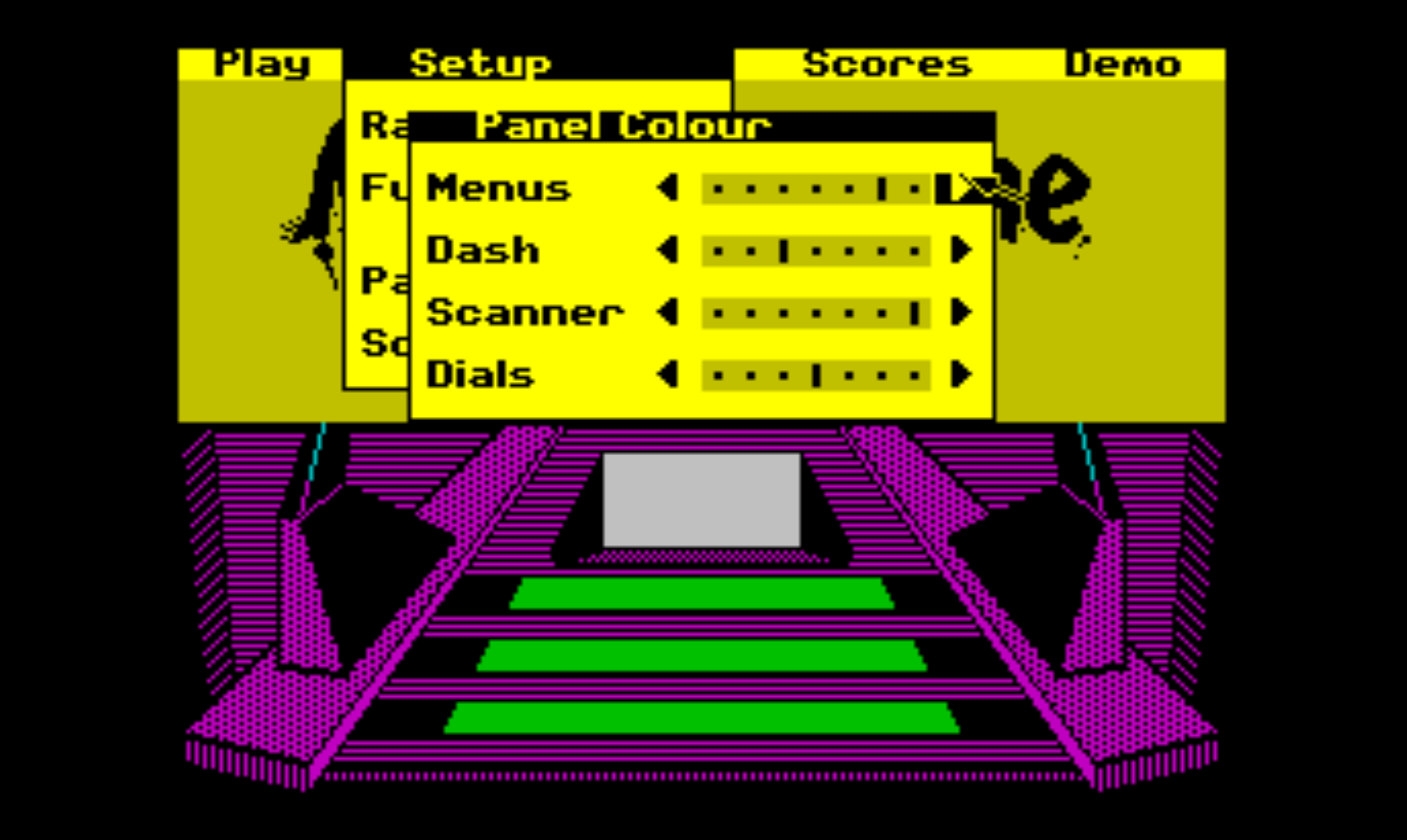 > > It has a menu/pointer configuration system. This may seem old hat, but back then this was virtually unheard of in 8-bit games. This system allows you to configure the game down to the smallest detail and lets you navigate the complex mapping system. It even lets you change the colour of various parts of the UI! > > Next, it has a kind of mini-wiki built into it, giving background details on the ship and its inhabitants. Honestly, this was so unheard of back then, I can barely think of another example, let alone one this well presented. > > 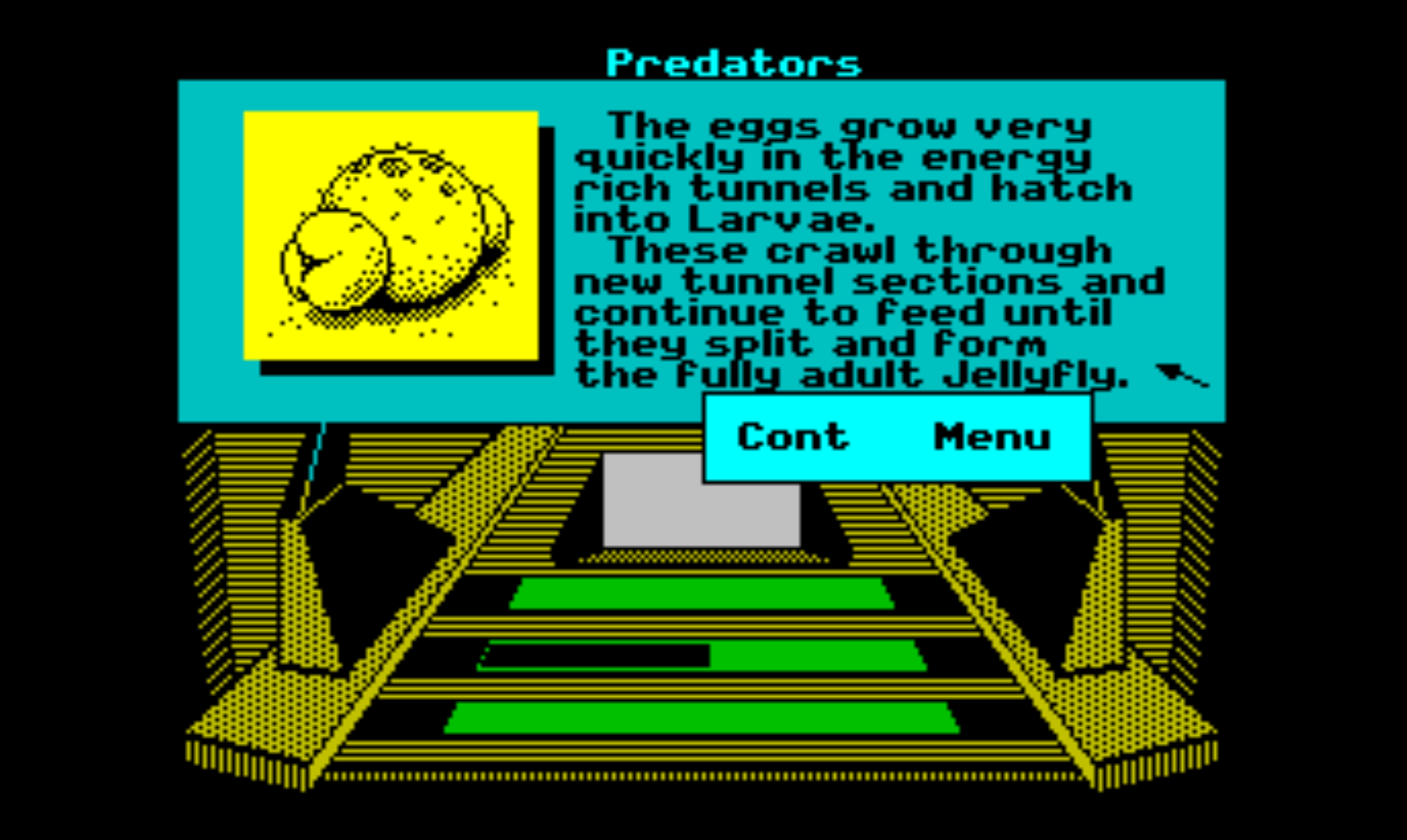 > > In game, you're giving access to a map, and on that map you can set waypoints which the game will then plot routes between. As you're playing, your HUD will display an arrow telling you which way to go... again, this feels like something from the late 90s! > > On top of all that, as well as the main game, Micronaut One also lets you play a racing mode, in which you compete against a "pacer" through the twisting corridors of the ship. It has leaderboards, various levels of pacer speed... It's amazing! > > 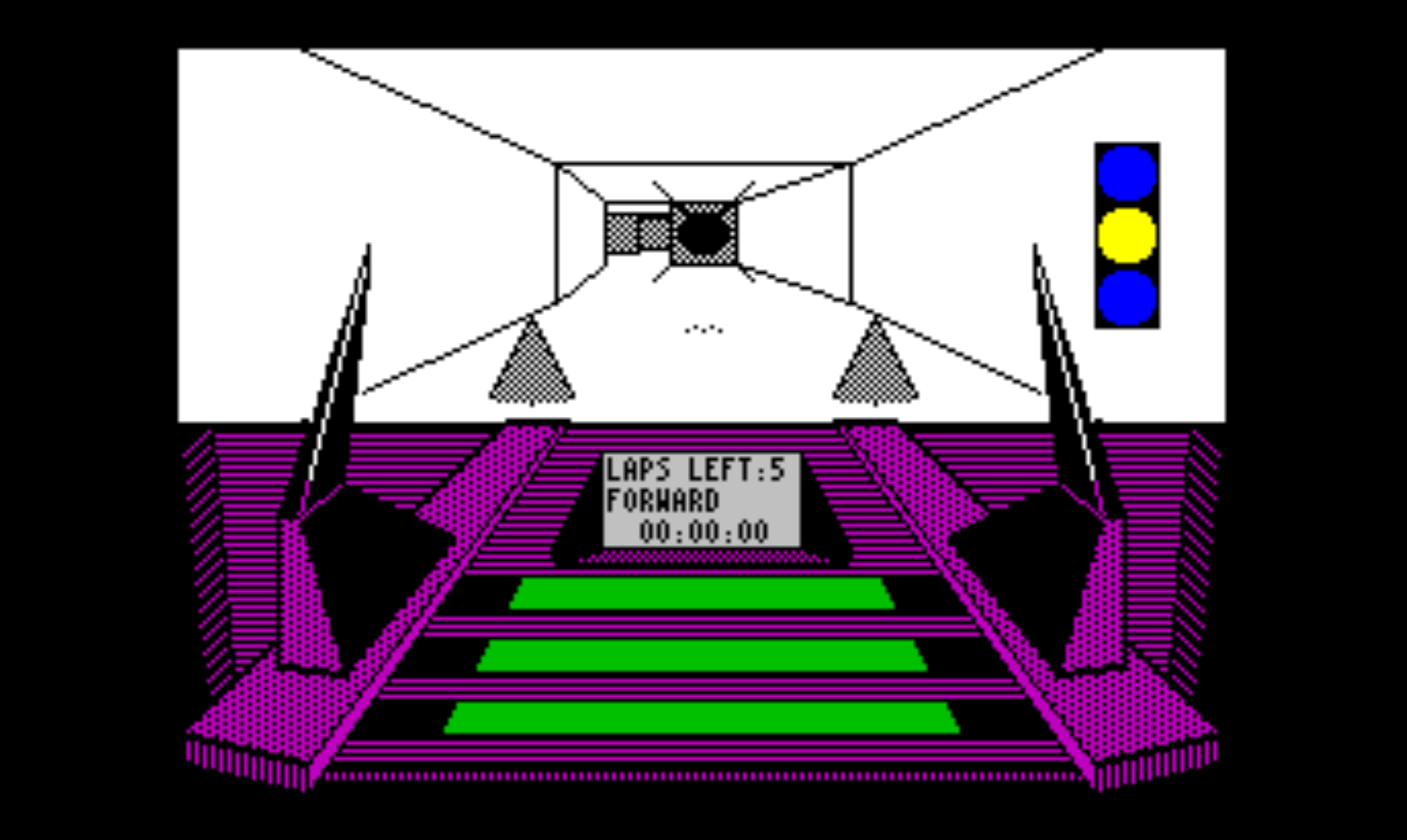 > > So, is it the best ZX Spectrum game ever? > > No, sadly not. Despite all of its gratuitous innovation, it definitely has its shortcomings, some of which are especially vexing to a modern eye. > > It is clunky to control, as you can't turn around in the corridors. Instead, you need to stop and then hit reverse, flipping your direction. This can lead to lots of alignment issues, as there are no strafe keys. Also, the menu can be difficult to navigate, requiring you move the "mouse" from side to side of the screen to back out to the game. And the sound is typically Speccy... ie, bleeps and burps and not much else. > > But all that's wrong with it feels like something that could be fixed with a couple of months of extra work and a couple of decades of hindsight (strafe keys, a back button in the menu). > > It feels like a shame that Micronaut One never got a chance to get an Amiga sequel, or a PS1 reboot. Instead, we should content ourselves with the fleeting moment of brilliance that was all this curious little game ever became. > > #ZXSpectrum #Retrogaming
Russ at Retro Game Corps seems to like the 2S, and I'm tempted myself. Is anyone planning to pick one up?

Everyone knows about Final Fight, right? This 1989 Capcom beat 'em up feels almost genre defining, even though it was not the first beat 'em up of its type. Nevertheless, it cast a long shadow over games that came after it, especially those released by Capcom. And with good reason. Final Fight is awesome, even today. It's a simple enough concept - gang kidnaps ex-Street Fighter and new Mayor Mike Haggar's daughter, so Mike and his pals Cody and Guy undertake a mission to save her. Said mission involves beating up fools, swinging various weapons, taking part in a wrestling match at one point, and eating lots of food out of trashcans. You can play as either of the three pals, and even bring a pal of your own along as a second player.  It's a lot of fun, and well worth a look today. It hurls hordes of bad guys at you that you slice through with kicks and punches and special moves. Nothing quite beats the feeling of your guy disappearing under a pile of ruffians, only to emerge with a cyclone kick to send the bastards flying. But it was also a technical powerhouse, with massive sprites, detailed backgrounds and a ton of stuff on screen at once. So how the hell would this behemoth fit into a humble ZX Spectrum? Grab a trash-chicken and let's find out...  Let's deal with the Amstrad and Spectrum versions together, since they share a lot of the same DNA, not to mention failings. Okay, there's no two ways about this. 1991 was way late in the life of the 8-bit home micros. They were about two generations behind the curve at this point, and time had not been kind. So any hope of getting a decent port of Final Fight onto these two was wishful thinking at best. Yet, somehow, someone thought it might be a good idea... There are two ways you can look at these versions. First, you can judge them on merit. And, honestly, they come up wanting. They're both terrible games, by any measure. To their credit, both attempt to copy the arcade to the best of their abilities, including all three playable characters, all stages, most moves, a representative sample of the animation frames... but it's this ambition that cripples both ports. Because the result is a slow, jerky, indistinct mess (especially on the monochrome Spectrum) that is really difficult to play. Moves take forever to animate, collision detection is terrible, every single-enemy fight is more like a boss fight in the length of time it takes to play out. There are glitches aplenty and both versions share a quirk that sees your character getting frozen to the spot after every punch or kick, standing there like Mitch McConnell while the enemies pile on. On top of that, weapons are useless, Cody and Guy are useless, and the game generally feels like a kind of torture.  But there's another way of looking at them... because there is clearly some achievement there. They are both recognisably Final Fight. The sprites, the locations, the enemies, all reasonable representations of Final Fight. They play like Final Fight, albeit Final Fight shot through a prism of shit. They attempt big boy feats they have no business doing, like the animated train on level two, or the wrestling arena. They both have the fancy animated intro... these are clearly not mindless cash grabs. There was talent here, talent that pushed these two machines beyond what anyone would have thought possible in 1982. It just feels like wasted effort. Worth a look for novelty value alone.  I've kept the C64 version apart from the other two because it is a very different beast, and a very different kind of bad. As is often the case, the C64 went its own way and knocked out a port that feels inspired by Final Fight at best. The levels are similar only, the sprites are smaller, the whole feel of the game is different. It has a weird kind of floaty feel to it. There's this strange quirk where landing a kick will only have an effect a short time later. So you'll kick a dude, you'll get a sound effect, then about half a second after that, the dude will fly backwards. It's almost surreal. The thing is, this port almost feels like it could have been a decent game. Just rounding off the sharp edges would have helped a lot, and it could have been a fun two player beat 'em up in the Renegade style. It's just not Final Fight.  Surely things are better on the 16-bit micros, right? Well, yes and no. The Amiga port is clearly superior to the 8-bits. It has some great intro music, the graphics are colourful, the sprites massive and reasonably well-animated. It just has that undeniable Amiga-arcade-port quality of something feeling off. It doesn't feel fluid or hectic like the arcade. There are fewer enemies at once, the control is hampered by a one-button joystick and feel sluggish, and the difficulty feels off, with stunlocks happening far too often. But it's not the worst Amiga arcade port out there, and would probably serve you well if you were looking for bit of quick mayhem.  The same can't be said of the Atari ST port, sadly. This version looks similar to the Amiga, but with fewer colours. It has some terrible character-block scrolling that wouldn't look out of place on the Amstrad. And the sound is about Spectrum quality. Not the ST's finest hour.  Over on the console, and things look a little better, as you might expect. Starting with the SNES version, which is definitely the runt of the litter. It's not terrible, it plays pretty well, it just feels cut down. That's because it is... only two characters available (sob, poor Guy). No two player mode. Some weird early-90s censorship that saw various female enemies replaced by cookie-cutter male hoodlums. A whole missing level. Some missing level transitions. And a generally drab looking appearance. Not awful, but not great by any means. It should be noted that Japan got a version called "Final Fight Guy" which returned Guy to the game... at the expense of Cody. So close.  Let's end on two high notes. The Mega CD version of Final Fight is superb! From the animated, voiced intro, to the faithful reproduction of the gameplay, to the extras that this version includes, everything feels complete. It plays well, it sounds amazing, it is the first port so far that actually captures the essence of the arcade incredibly well. It has lots of enemies on screen at once (not quite as many of the coin-op, but better than the SNES). If I was compelled to level but one criticism, it would be that the colour palette feels a little off, which is probably a limitation of the Megadrive itself. It just leaves things looking a bit... gritty. But that shouldn't deter you! This port is awesome and well worth a play!  But for all that the Mega CD version is great, it's not my favourite... That accolade goes to, surprisingly, the Gameboy Advance! The GBA got a port titled "Final Fight One", which is basically a port of the arcade, so it counts. Unlike the SNES, all characters are present, as is a two player mode via link cable. All stages are here, and the game generally looks a lot more vibrant. Due to the nature of the GBA screen, it does feel a little "zoomed in", but you get used to it. Where this port succeeds the most is in how it plays. It is fluid as hell, fast and easy to control. You get the same frantic feeling as the arcade, with lots of enemies flying all over the screen. The music really adds to this feel, with some cool renditions of the arcades tunes. Overall, a really complete package and well worth playing today! So what are your memories of Final Fight? Did you suffer through the Spectrum version or were you lucky enough to get the Mega CD port?

Miyoo Mini Plus here, where I’m currently playing through GBA Advance Wars, which I’ve somehow never played before. It’s absolutely perfect for a half-hour pickup. So, what are you playing? Let me see those handhelds!

Vigilante was a 1988 Irem coin-op, a kind of spiritual successor to 1984's Kung Fu Master/Spartan X. Like the 1984 title, Vigilante had a simple premise - you walk to the right and beat up fools in front of you and behind you. There's no pseudo-third-dimension, no in and out, it's just straight up single plane brawling, taking on ruffians before they get the jump on you. At the end of every stage, you fight a boss, then those self-same ruffians drive a van away containing your girlfriend... Madonna. It's never made clear if it's the real Madonna you're trying to rescue, or just *a* Madonna. But rescue her you must. And to help you do so, you can find a wide array of weaponry that can be used to dispatch fools faster. Weapons such as nunchuks and... actually, just nunchuks.  Vigilante isn't a terrible game, but it's not a great game either. It certainly has a distinctive look, with characteristic late-80s chunky sprites, this time with thick black borders that really make them pop. The main character is recognisable and distinct, sporting a fetching pair of dungarees, and the levels look suitably grungy. But it's just not that interesting. Literally all you do is move forward and hit people, the skill being in how you cover your front and back effectively. So, from a pretty low baseline, can the home ports inject any kind of interest? Let's take the power into our own hands!  Top of the shitheap, as always, is the Amstrad version. It's especially bad this one, with the usual trademark Amstrad chunky-colourful graphics and rage-inducing jerky scrolling. In it's defence, it doesn't look too bad in still form, it's only when you see it moving that you experience the true horror of it. It's main problem though is not its looks - it's how it plays. There's no sense of actually fighting, hits aren't clear, the sound effects give no clue. You just kind of move forward and mindlessly mash. At one point, some guy just started following me. He didn't attack, he wouldn't even face me. When I approached him, he moved away. It was one of the spookiest glitches I'd ever seen. Eventually, I had to let the time run out on the level, because he just couldn't be killed. Another time, my guy "fell" down to a lower level where the goons couldn't touch him and I was able to finish the level. So it's a bit buggy... Oddly, when I got to the second level, I found myself warming to it... which pretty much proves that Stockholm Syndrome is a thing! Must try harder, Amstrad!  Nibbling at the shitty coattails of the Amstrad version, is the C64 port. The C64 normally does well in these comparisons, excelling at music, sound effects and graphics. Not this time. Vigilante on the C64 is as drab and unappealing as a wallpaper paste cocktail! It just looks so bleak and recreates nothing of the arcade. It is jerky in motion and slow as hell, with the main character sauntering along with all the urgency of a tranquillised sloth. But its most egregious sin is not in the looks department - it's the music. It's atrocious, jarring, repetitive, grating... exactly the opposite of how C64 sound *should* be. Foreshame, C64, foreshame!  Having just lambasted its 8-bit cousins for their shoddy visual recreations of Vigilante, you might expect that I'd whip the Spectrum with the same stick? ... Are you new? Listen, the Spectrum version of Vigilante is no looker. It's a headache waiting to happen in places, with gaudy blocks of colour and a flippant, devil-may-care approach to colour clash that is almost commendable in its audacity (though, it does offer to let you play in monochrome, something I've never seen any other Spectrum game offer!) But we expect that from the Spectrum, and it's not the worst looking Spectrum game out there... So we can be a little bit more forgiving of its visual failings (of which it has many) and look beyond them to the game itself. And... as is so often the case... the Spectrum manages to turn in a B+ recreation of the Vigilante arcade experience! It's smooth enough, it controls well, it hits you with enough enemies to make it feel like the coin-op. All the levels are intact, as are most of the bosses. The enemies are recognisable. It's... not bad to play. It just looks like sick.  On to the Amiga, and I'm forced to pick up my lambasting stick again. There is no reason why the Amiga version should be this average. Granted, it's not quite the appalling war crime that the Amstrad and C64 versions are, it is at least playable. It's just so... meh. The graphics are meh. The sound is meh. It has juddery scrolling, somehow. It's one of those mid-generation Amiga ports that feels like the devs didn't quite know what the Amiga was capable of, a veritable Atari ST port if ever I saw one. Sigh.  Okay, let's leave the home computers behind and finish up on a few high notes. First up is the Sega Master System, punching above its weight as is so often the case. This port makes a few changes - Madonna becomes Maria, and the gang you're fighting change from "The Skinheads" to "The Rogues". No idea why. Visually, it does a good job of recreating the arcade, albeit with a lick of SMS paint. The sprites are small, but have character and the whole thing controls well. Sound is good, in both vanilla SMS audio and fancy FM sound. And it generally plays quite well. There's an interesting quirk in this version where you can basically jump over a significant portion of the enemies. They run at you, you jump, and they carry right on by, never troubling you again. Not sure if this is intentional or not... If I had to offer one criticism, it's that, unlike the other ports, this one sends you back to the start of the level when you lose a life, even if you'd made it to the boss. Still, a good effort generally.  Saving the best till last... When it set its mind to it, the humble PC Engine was capable of doing some quite amazing things - see its port of R-Type for proof - and Vigilante is thankfully one of those amazing things. Its resemblance to the arcade original is uncanny at times, with a similar colour palette, the same chunky sprites, the same black outlining. It sounds great, with beefy effects and some great tunes. Most importantly, it actually plays really well. I'd almost say I prefer it to the arcade, it feels more forgiving. Unlike all of the other ports, it reproduces the bosses in their entirety, including the twins on level 2. That said, it doesn't really add anything, and the gameplay experience is ultimately haunted by the same ghosts of mediocrity that the arcade original has. But if Vigilante is your cup of tea, then you could do a lot worse than picking up a copy of the PC Engine version!

If fur loincloths and large axes are your thing, then the eighties was a hell of a time to be alive. It seemed like barbarians were everywhere. In movies, there was Conan the Barbarian, Red Sonja and Beastmaster; on TV we had He-man and the Dungeons and Dragons cartoon (Bobby was technically a barbarian!); and in videogames you could live out your wildest horn-helmed fantasies while playing the likes of Rygar, Barbarian 1 & 2, Legendary Axe and, of course, Rastan Saga...  Rastan Saga (just Rastan in the US) is a 1987 Taito coin-op in which you play Rastan, a mighty king who is reliving his past adventures as a lowly barbarian. The gameplay takes the form of side-scrolling hack and slash, in which you move left to right and dispatch an endless horde of soldiers, monsters and bosses. Along the way, you pick up various items that boost your stats temporarily and various weapon upgrades, the best of which is a fireball shooting sword. It's a fun game with some detailed and imaginitive graphics and atmospheric music. It's also incredibly hard, with some parts being veritable coin-guzzlers (the fire pits at the end of level one, for example!) It also punishes any hint of methodical play by sending flocks of bats after you the moment you start to shilly-shally. Damned those bats! Rastan Saga wasn't widely ported, but it did arrive on the 8-bit micros and a couple of other platforms. But are any of the ports worth playing today?  The least impressive port is definitely on the Amstrad. On the positive side, it is very much an Amstrad port in its own right, rather than a lazy Spectrum port. It's bright and colourful, with a chunky Rastan sprite. But it is sooo slow and the scrolling is jerky as all hell. It also has a weird quirk where the ropes you climb aren't reachable with a normal jump and require a more coordinated super jump. This results in lots of lost lives, as you're swamped by enemies while you try to hit the right pixel spot. It doesn't even attempt the music, settling for just a few sound effects. I'd probably skip this one.  On the Spectrum, things are better, in gameplay at least. Looks-wise, it's no stunner. Mostly monochrome, as expected, with garish, distracting backdrops that tend to swallow a lot of the action and make the fire pit jump especially difficult. But it moves really quickly and controls just like the arcade. Most of all, it feels like the arcade, at least as much as can be expected. On the 128k models, there's a passable rendition of the Rastan theme that plays during the game and some spot sound effects. So, not a bad effort. Worth a look if you're a Speccy purist.  Okay, now we're talking. The C64 version of Rastan is really good! It's a little drab, but the graphics are distinct and chunky, and the scrolling is butter smooth. It has all of the moves from the arcade, and the levels are faithful renderings of the originals. The music is predictably good, playing throughout gameplay. But, man, is it hard. The firepit jumps on level one are especially punishing, as are the log jumps on level two (I never got further than this, even with cheats). If you're going to play one of the 8-bit micros, give this a look. It holds up surprisingly well!  The last of the arcade-faithful conversions was on MSDOS machines. It's surprisingly good, with the Rastan sprite being a commendably chunky boy. The music is good, the sound effects are good and the graphics are like recoloured versions of the arcade. My only real complaint is that it feels zoomed-in, which leads to it feeling a bit claustrophobic. Like the other ports, it is incredibly hard.  As well as the western computer ports, a couple of conversions came out of Japan, with Taito undertaking the work themselves. For some reason, they chose to "reimagine" the game, keeping the structure and asthetic, but rearranging the levels. This kind of works, but also tends to lose something from the source. I'll include them here for completeness. The first of these ports was on the Sega Master System. It's a good game, bright and smooth with very clear graphics. The main character is like a mini-Rastan, but it works to keep the speed up and avoid running into sprite limitations. In this version, you only get one life, but a more generous health bar. The levels are a also lot shorter and the bosses a lot easier. I found I had no trouble progresing quite far into this - no fire pit on level one helps! The basic SMS soundchip produces a passable, chip tune version of the theme music. And if you were posh enough to have the FM chip, you get a much nicer, fuller rendition. Overall, it's a really good conversion. But is it really Rastan?  Finally, we get to the MSX2, a platform not normally seen around these parts. This port is similar to the SMS version. Same modified levels, same smaller sprite, same difficulty. The graphics are slightly more detailed in parts, though the enemies are monochrome. It has a good rendition of the theme music and nice sound effects. But it seems a little easy. It's sometimes better to just super-jump your way through the levels rather than stand and fight. That jump is very high and very floaty, which doesn't feel very "barbarian" at all. Worth a look for novelty value. So, if you're going to play one today, which should you check out? I think I'd go with the C64 version personally, but the SMS port is also worth a look if you don't value accuracy too much. Note: there's also an Apple IIgs port, which looks pretty faithful on YouTube. Sadly, I don't have access to a IIgs emulator or MiSTer core. Has anyone played it?

What videogame jumps into your mind when you think of couch multiplayer? Halo? Goldeneye? Overcooked? For me, couch multiplayer gaming will always be California Games. It was a game that my friends and I played endlessly back in 1989. Couldn't get enough of it... To this day, it remains one of my favourite Sega Master System games. It also got a ton of ports... but were are any of them any good? Join the hack and find out, my dude... 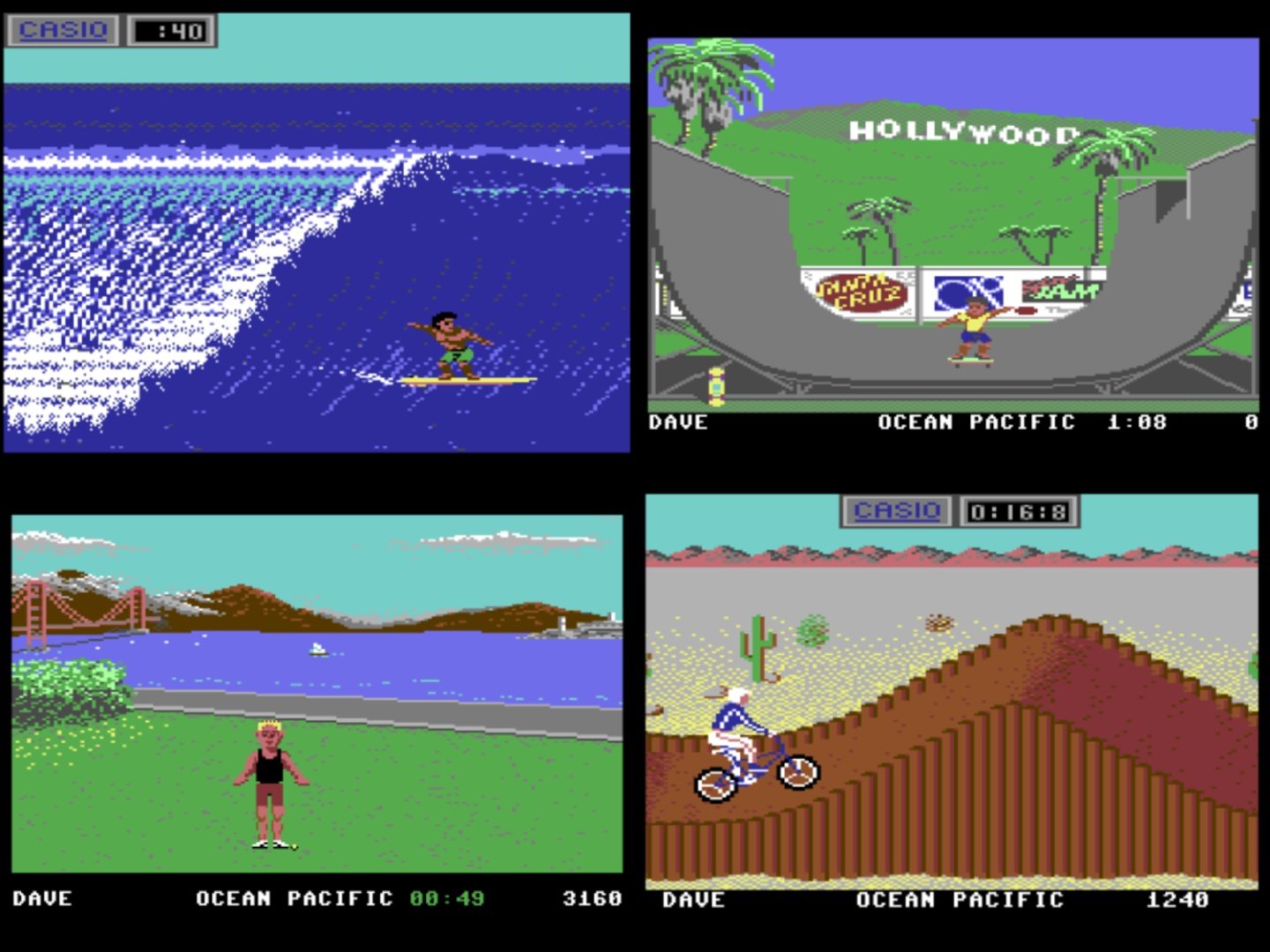 California Games was originally developed by Epyx for the C64 and Apple IIe. It's an event-based sport sim, of the kind that was popular in the late 80s. Think Hyper Sports, but with more 'tude. Events included: half-pipe, foot bag (hacky sack), surfing, skating, BMX and flying disk (frisbee). Each involves various combinations of skilful control and button mashing. Overall, it's colourful and moreish, with just the right mix of DudeBro and SportsBro... Let's start with the original C64 port. Honestly, it's hard to overstate how much better this version is than the other 8-bit micros. It has it all - smooth controls, relatively colourful graphics, great sound. It also has far more interstitial graphics and menus than the others, as well as the "correct" list of sponsors. Some events are better than others - half-pipe is terrible, no matter which version it's on; while surfing is a lot of fun. Overall it's still worth a look today. 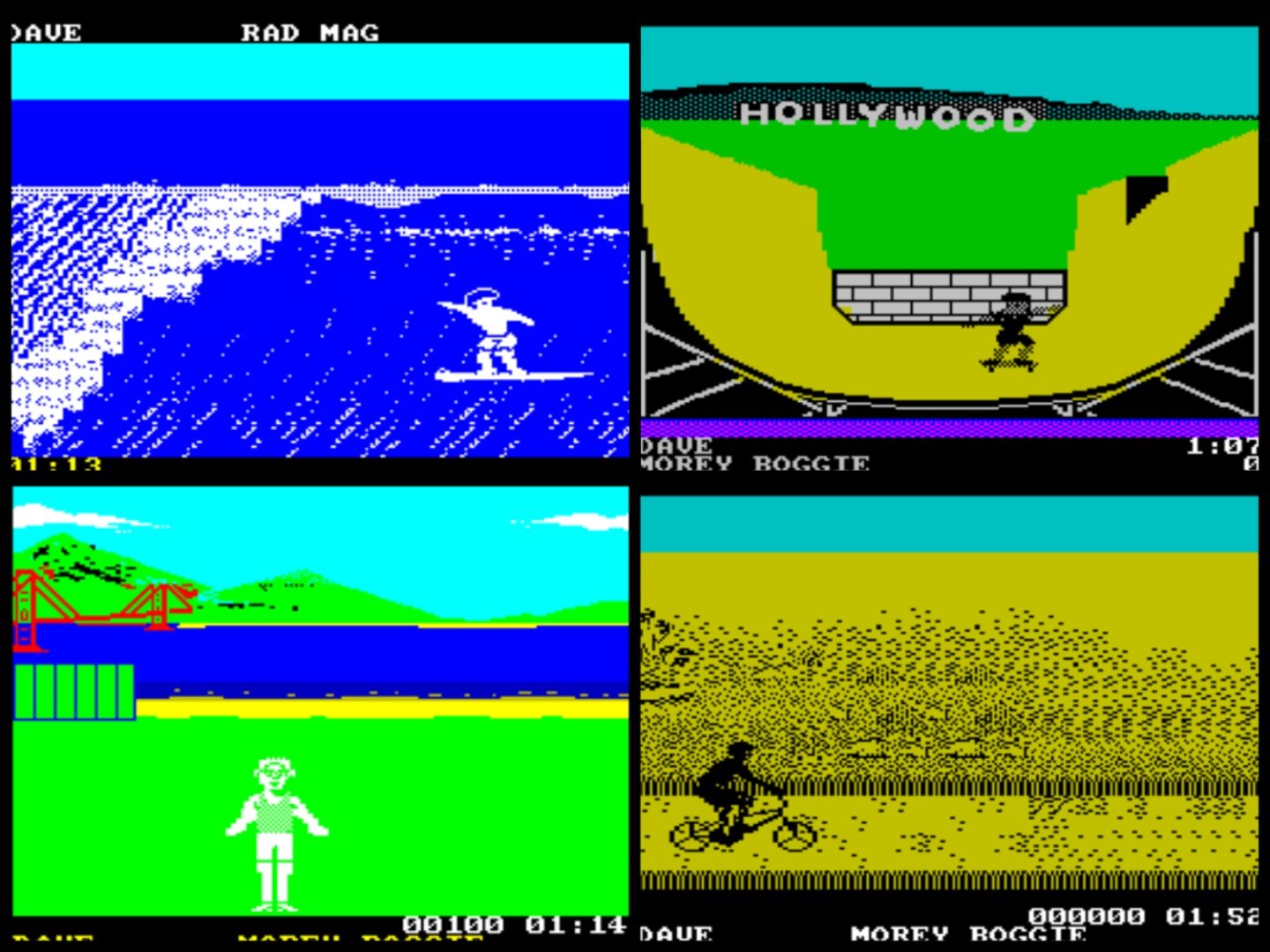 At the other end of the quality spectrum, is the *actual* Spectrum. Crash Magazine gave this version 36%, and I think that was somewhat generous. The graphics ruin this one, lacking even that classic Speccy-charm. One event in particular (BMX) looks like a borderline hate-crime. Sound is nonexistent, all of the colour and life has gone from the menus and control is pretty terrible. Buuuut, all the events are in there, and it moves reasonably well... So it could have been worse, I suppose... 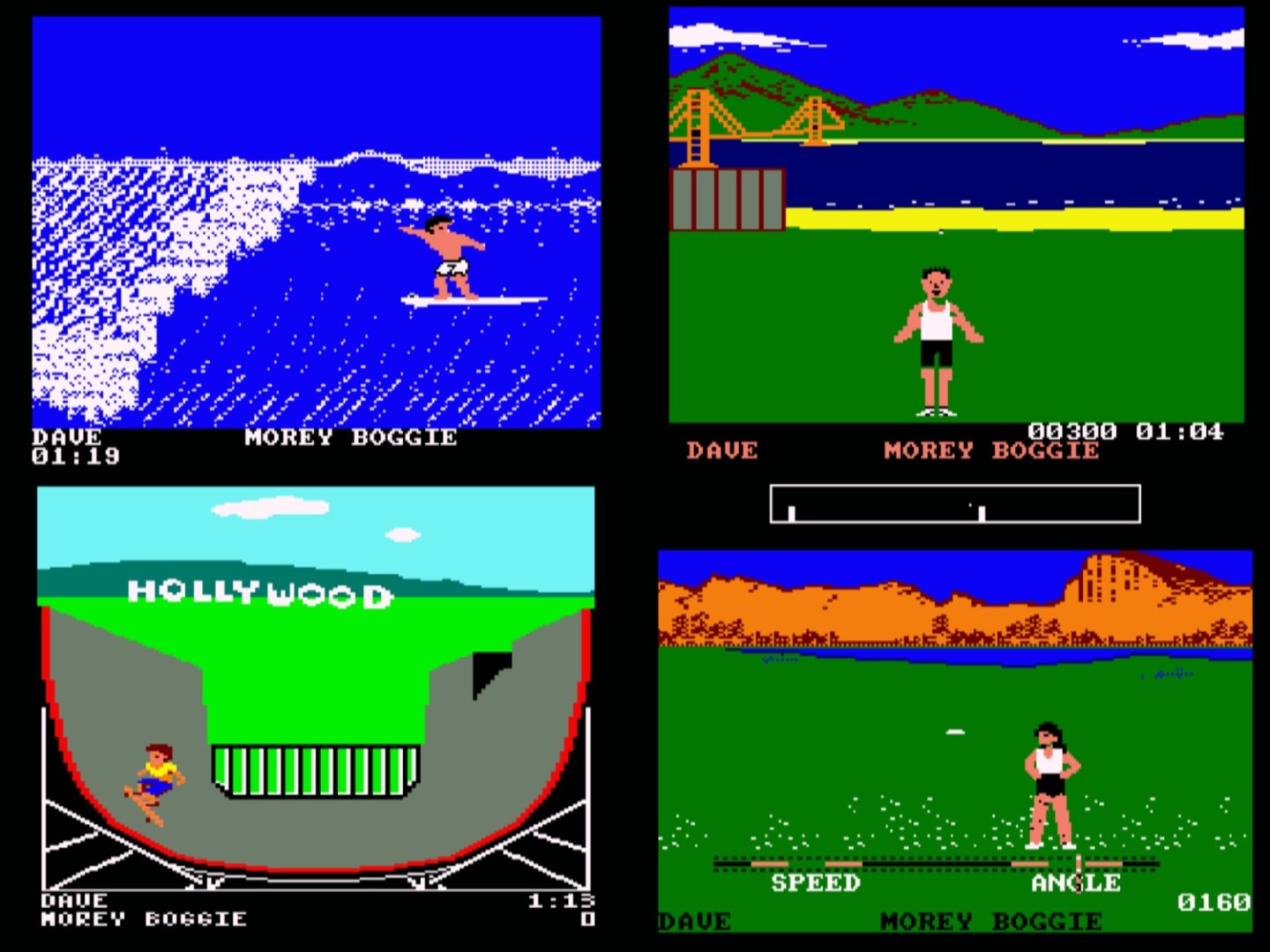 Speaking of "worse", we come to the Amstrad version... Oh boy. Basically, it's the Spectrum version, with a bit more colour and a lot less speed. The lack of speed really ruins this one, making it the sick relative of the already ailing Speccy port. It just makes the timing impossible... foot bag is suddenly painful, half-pipe ends up being impossible. Even surfing loses any joy. And, for some reason, the foot bag character is an out-of-shape, middle-aged man in a vest... This isn't the escapism I'm looking for in my games! Sorry Amstrad fans. 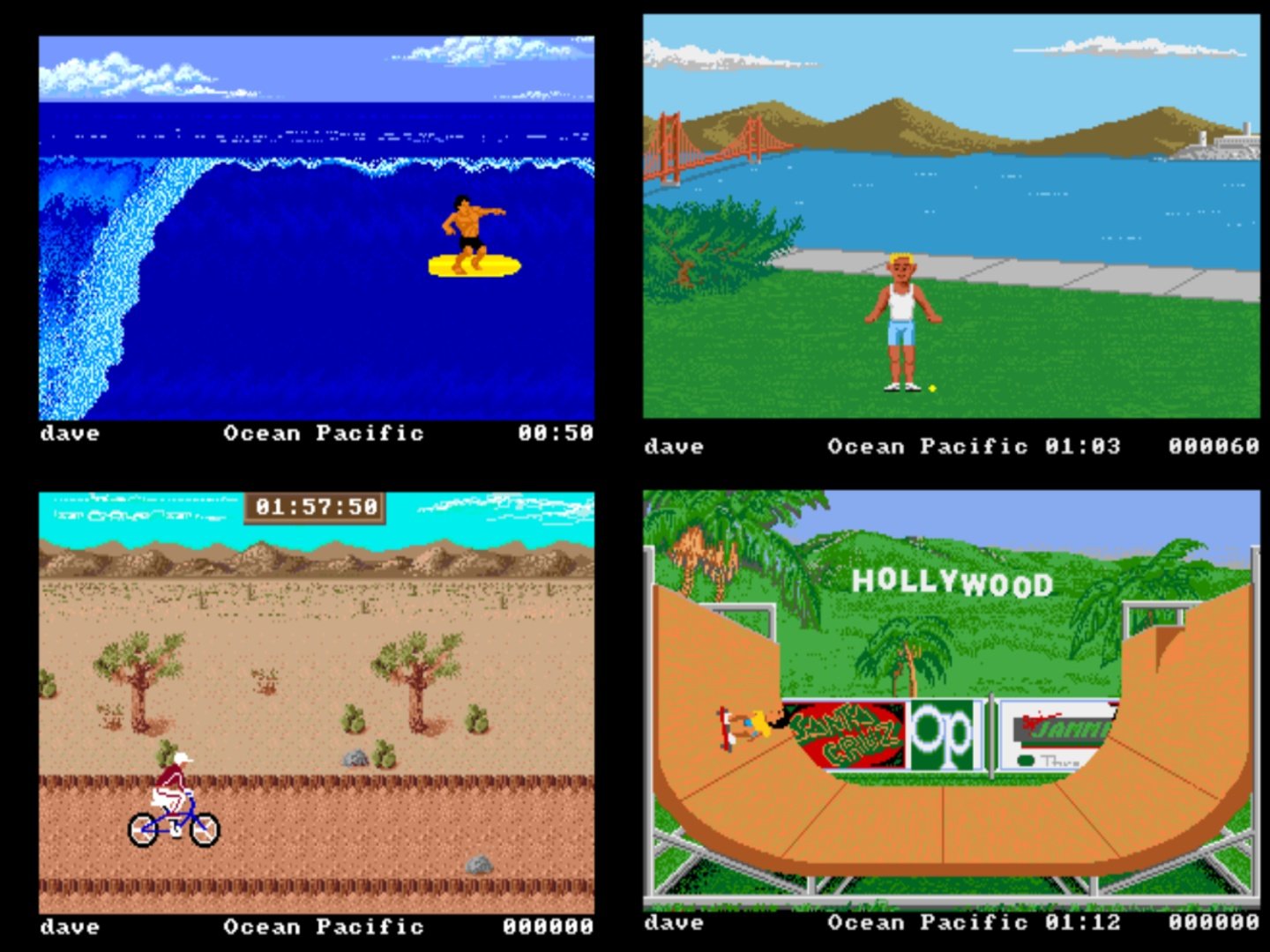 Next up is the Amiga version. Not a lot to say about this one. It's the C64 with a 16-bit lick of paint. It has the full menus and sponsors, some really funky Amiga-esque music, and generally plays well. Flying disk swaps a lady thrower for a buff dude, but that's about the only difference. A good, solid port. 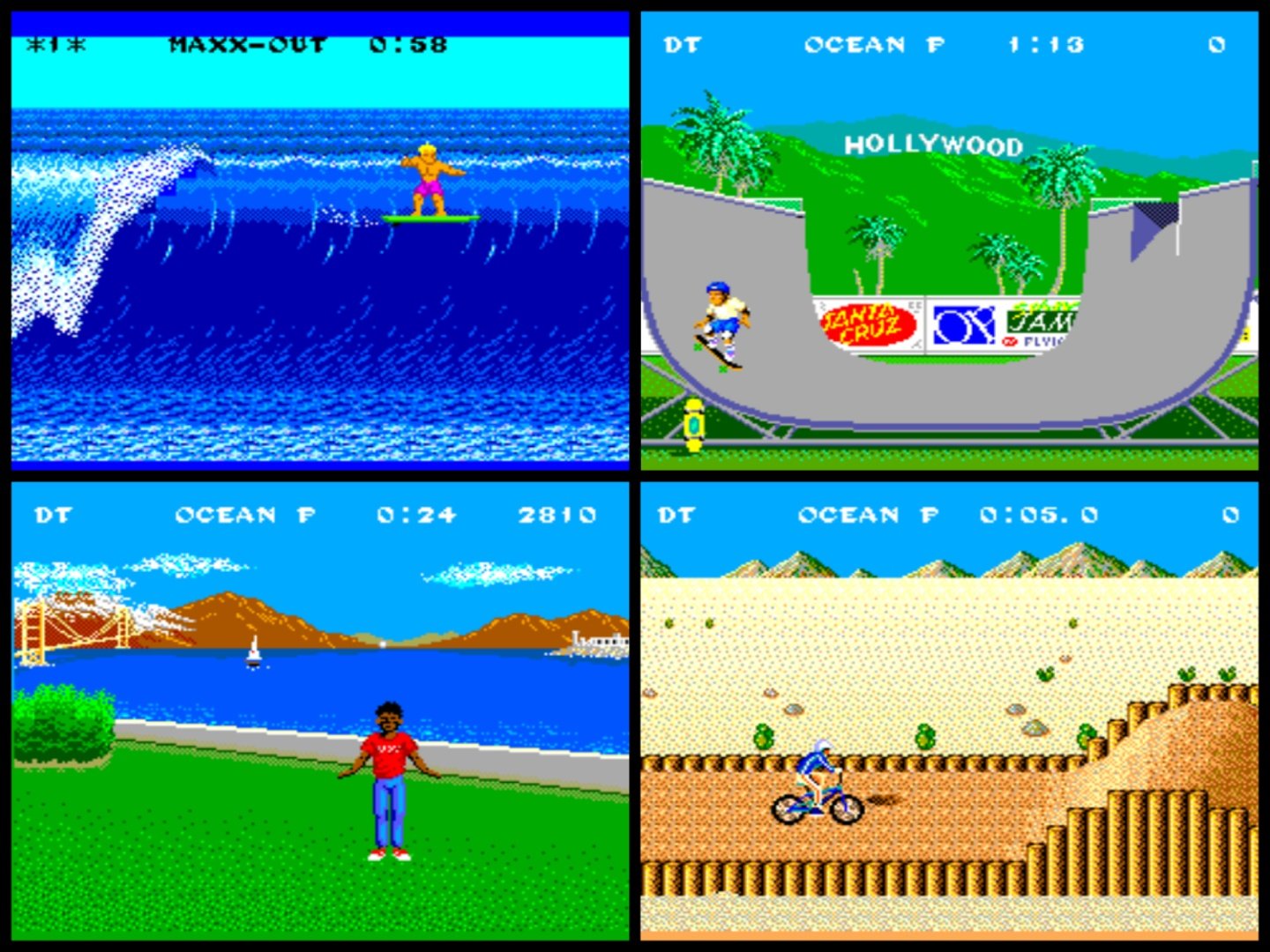 My personal favourite is the Sega Master System port. Something about this game really fits the Sega blue-sky aesthetic. The addition of a second joystick button adds some much-needed flexibility to the BMX event, and the console fluidity helps the timing on the half-pipe and foot bag events, making them both far more enjoyable. If you're going to play California Games, this wouldn't be a terrible place to start. 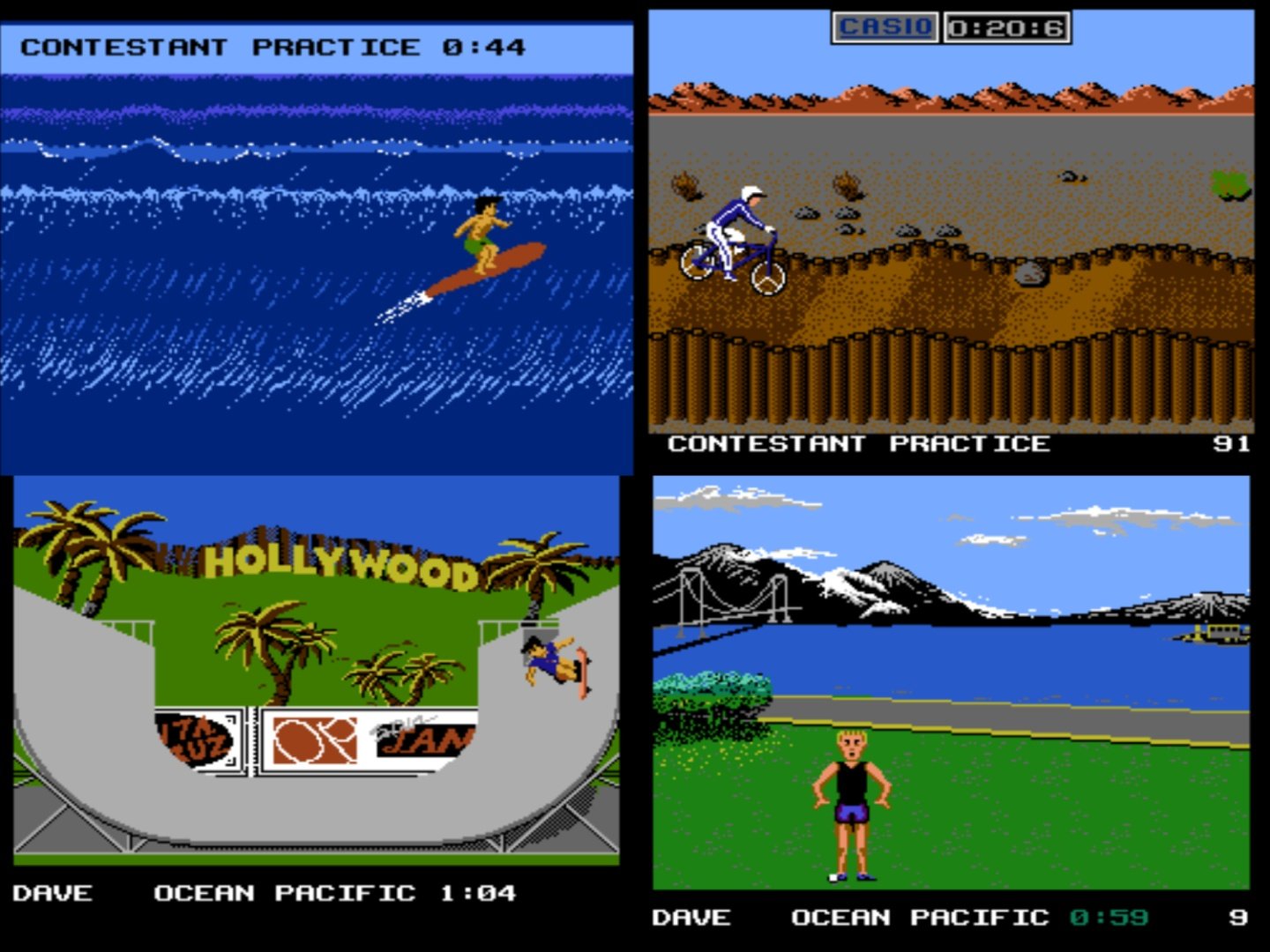 There's a NES port as well, which has all of the elements of the game, but just doesn't feel as "together" as the SMS version. It's a lot more drab, and the controls feel fiddly in places. Also, in the flying disk event, you seem to be throwing to your mum. And she doesn't look at all happy with you. Overall, not terrible, not brilliant. 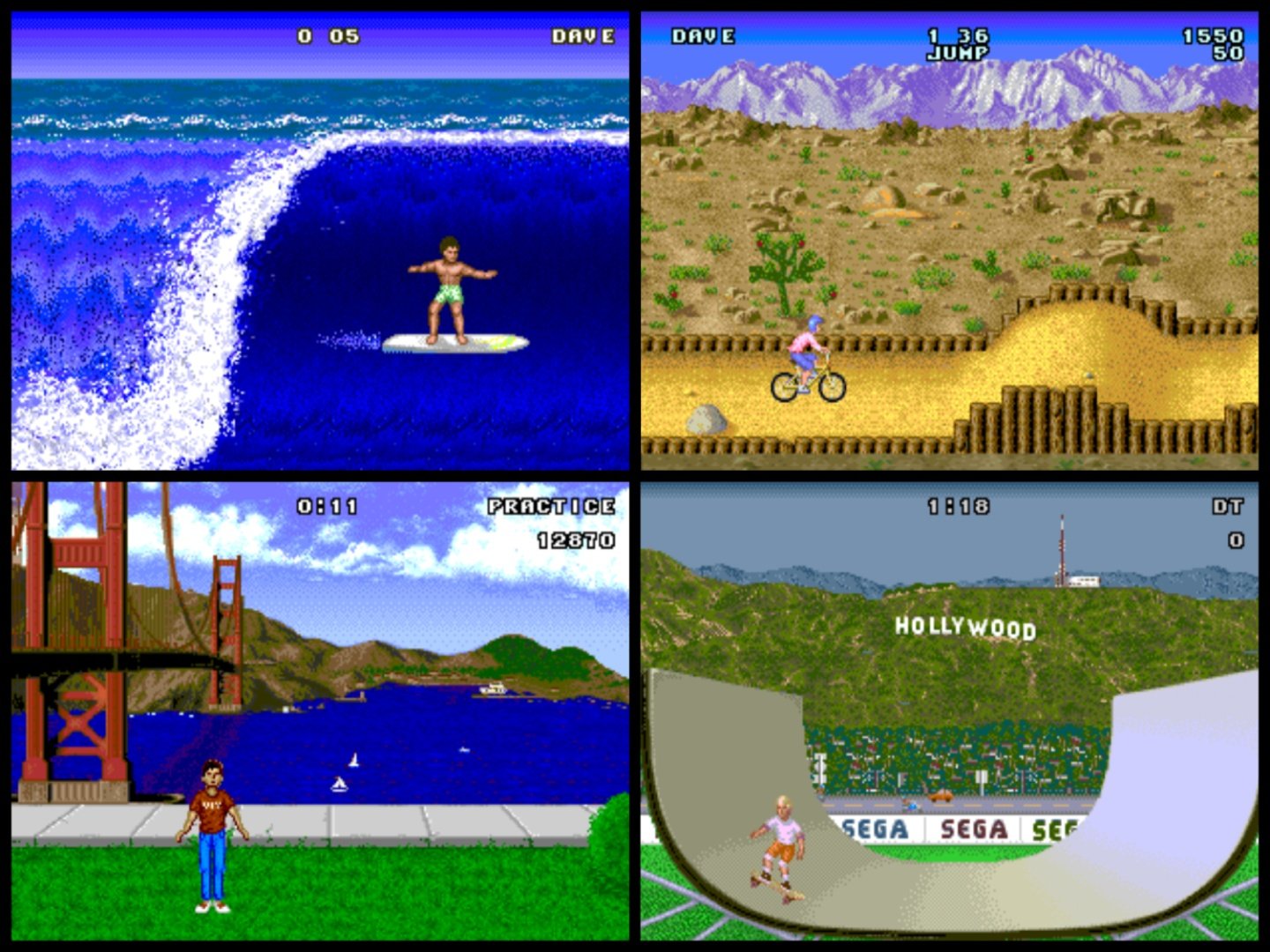 The MegaDrive version pretties up the graphics a lot, being by far the best looking port. Unfortunately, it seems to lose something of the simplistic charm of the game. It goes it's own way on sound and presentation in a lot of places as well. It also, bizarrely, omits the flying disk event... It's not a bad port by any means, it just feels like more of a re-imagining rather than a remastering.  If you lived your late 80s teenage life in computer magazines, as I did, you'll probably have an imprinted recollection of Californa Games on the Atari Lynx. It seemed to be the game that was running in all the photographs - that or Blue Lightning. This port cuts the events down to four, losing Skating and Flying Disk. It has it's own aesthetic and some funky scaling effects. And surfing goes to the left, weirdly. Overall, it controls and plays really well. 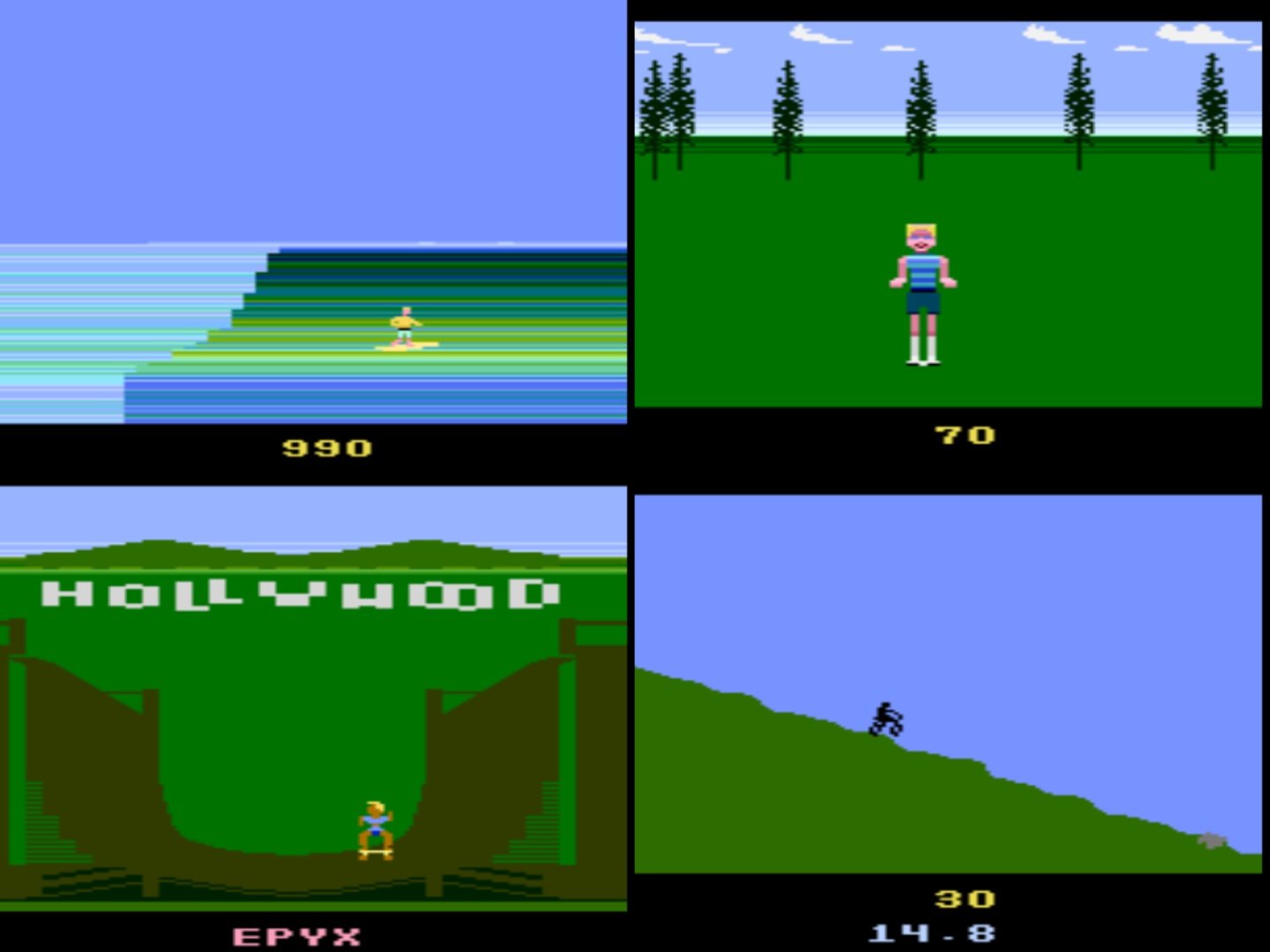 Finally, and most surprisingly, the Atari 2600 got a port, probably one of the last games to be released for the system. And, somehow, it isn't terrible! Don't get me wrong, it is cut back significantly, and some of the events are unrecognisable (BMX for example). But it plays like California Games, and it feels a bit like California Games. It's something of a miracle that it exists at all really... but if you were somehow still on Team 2600 in the late 80s, this would have brightened your day. If you're going to play one version: give the C64 port a go!

Some games arrive right on time, while some games arrive later than they should... but some, a rare few, arrive way too early. Like Micronaut One.  You've probably never heard of Micronaut One, and with good reason. It was a single platform, 1987 title that was released with little fanfare and to modest acclaim, on a platform largely only popular in Europe. It wasn't a sequel itself, nor did it generate a sequel or a franchise. It simply arrived, enjoyed a moment in the sun, then disappeared... To my mind, this is a great shame. Not because Micronaut One was an amazing game (it was more technically intriguing, in my opinion, than amazingly playable), but because Micronaut One was so far ahead of its time that it deserves to be more widely known. Even without digging into the finer details, Micronaut One sounds surface-level impressive. It is a first-person, solid 3D science fiction game, on the ZX Spectrum, of all things. In it, you pilot a craft around the winding, intersecting corridors of some great ship, manipulating the energy levels of various computer nodes in an effort to stop an overload. As you travel around, you encounter various fauna that inhabit the ship with you. These mostly take the form of "Scrim", an insect lifeform with a three stage growth cycle - from invulnerable eggs, to creeping larvae, to egg-laying flies. If you fail to destroy these creatures, they inevitably mature and start forming webs that block the corridors. Eventually, you'll find your route between the overloading nodes is impossible, and overload will be imminent...  If you know the ZX Spectrum, you can see that it's already pretty ambitious. It moves at a nimble pace in flawless 3D, looks great for a Spectrum game, and has a compelling game loop and tense atmosphere as you struggle to keep on top of the replicating Scrim. But it's the extra details that make this game especially impressive, and well worth a few moments of your time in 2023. In parts, it feels like a game from much later, 1997 rather than 1987 say. It's almost Descent, 10 years before Descent even existed.  It has a menu/pointer configuration system. This may seem old hat, but back then this was virtually unheard of in 8-bit games. This system allows you to configure the game down to the smallest detail and lets you navigate the complex mapping system. It even lets you change the colour of various parts of the UI! Next, it has a kind of mini-wiki built into it, giving background details on the ship and its inhabitants. Honestly, this was so unheard of back then, I can barely think of another example, let alone one this well presented.  In game, you're giving access to a map, and on that map you can set waypoints which the game will then plot routes between. As you're playing, your HUD will display an arrow telling you which way to go... again, this feels like something from the late 90s! On top of all that, as well as the main game, Micronaut One also lets you play a racing mode, in which you compete against a "pacer" through the twisting corridors of the ship. It has leaderboards, various levels of pacer speed... It's amazing!  So, is it the best ZX Spectrum game ever? No, sadly not. Despite all of its gratuitous innovation, it definitely has its shortcomings, some of which are especially vexing to a modern eye. It is clunky to control, as you can't turn around in the corridors. Instead, you need to stop and then hit reverse, flipping your direction. This can lead to lots of alignment issues, as there are no strafe keys. Also, the menu can be difficult to navigate, requiring you move the "mouse" from side to side of the screen to back out to the game. And the sound is typically Speccy... ie, bleeps and burps and not much else. But all that's wrong with it feels like something that could be fixed with a couple of months of extra work and a couple of decades of hindsight (strafe keys, a back button in the menu). It feels like a shame that Micronaut One never got a chance to get an Amiga sequel, or a PS1 reboot. Instead, we should content ourselves with the fleeting moment of brilliance that was all this curious little game ever became. #ZXSpectrum #Retrogaming

In the UK, we have a peculiar turn of phrase: "to make a good fist of" something. It means to put up a good show, to make the best of what you have, to succeed despite your challenges. And if you ever need to demonstrate to a non-English speaker what this means in practice, you can show them the 8-bit micro ports of Golden Axe! Neither the Amstrad, C64 or Spectrum should be capable of running this game well. Yet, somehow, they all make a really good fist of it. But which fist is best? [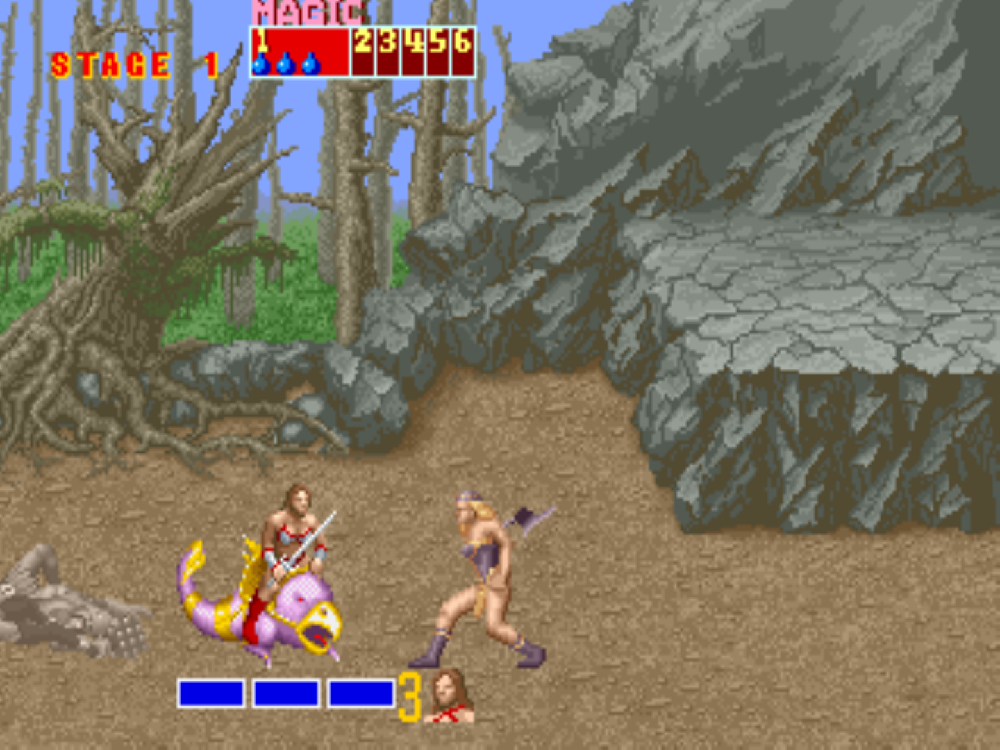](https://lemmy.world/pictrs/image/957d2409-4238-4ead-93f9-b50e646f6fc5.png) Arcade Golden Axe is a Sega classic. A two player fantasy hack 'em up, with three playable characters, some incredibly detailed and imaginative locations and enemies, a great soundtrack and plenty of goblin kicking. It also came pretty late in the lifespan of the 8-bit micros, around 1990, a time when arcade conversions to the trusty three stalwarts were money generating afterthoughts, intended to milk a captive market hungry to play the big games. It's fair to say, expectations weren't high... [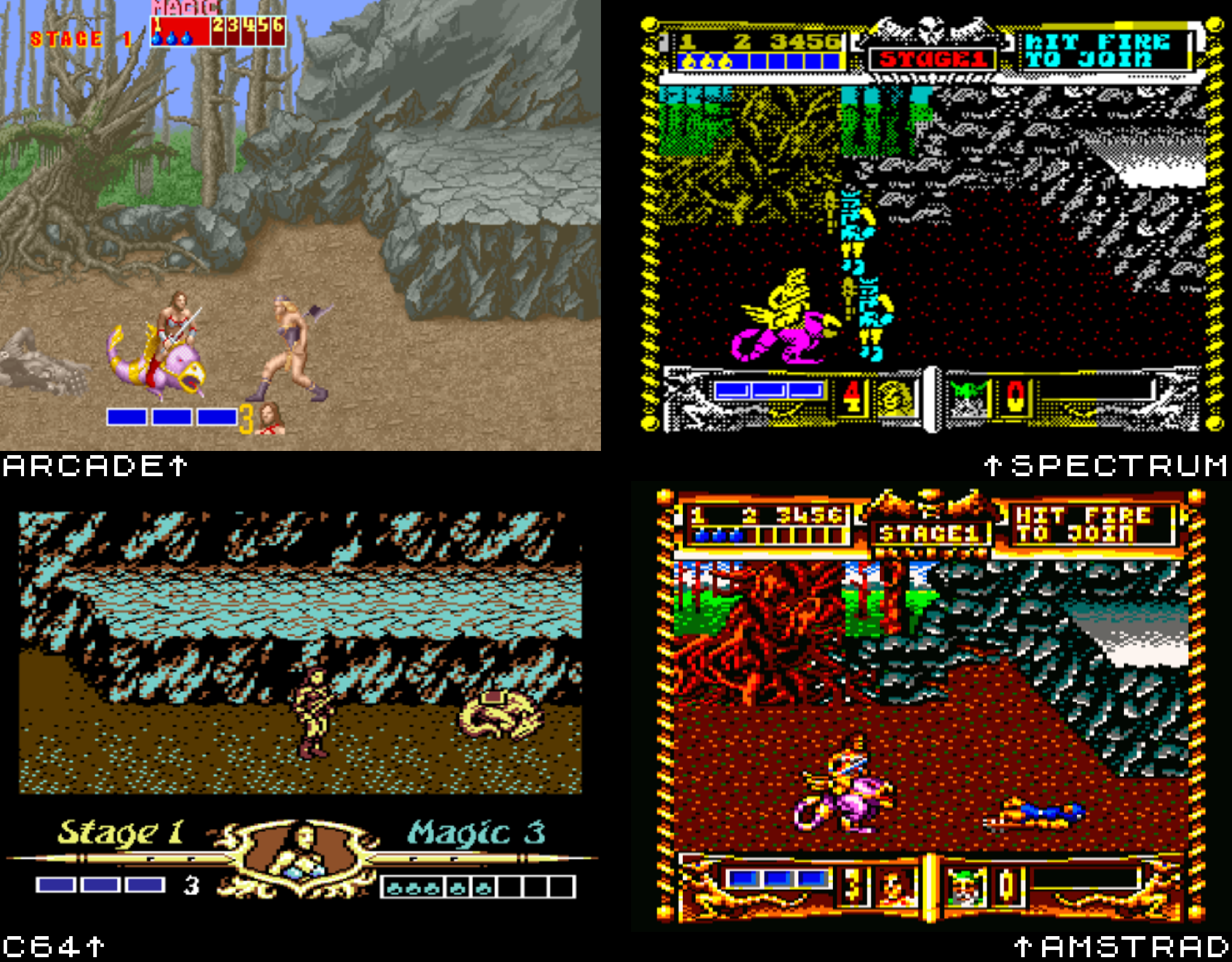](https://lemmy.world/pictrs/image/1f08d61e-4643-4ad1-80c0-6e5e7700ec24.png) Worst of the three is, surprisingly, the C64 version. But, it's not terrible. It moves well, controls well, and the music is really good. It just feels extremely cut back. It loses the two player mode of the other ports and generally has only one enemy on screen at once. Some of the enemy and creature placement is different as well. Shame, because it looks pretty nice in motion. Next - and I'm going to have to ask you to trust me on this - is the really quite good Spectrum version. Okay, so it looks like a bad Ceefax crash, but if you look beyond the graphics there's something of a game in there. It *feels* like Golden Axe. It has the same enemy placement as the arcade. It has two players. It has all the playable characters. It just looks... bonkers. But the best 8-bit micro port of them all, is the Amstrad version! It is obviously cut from the same cloth as the Spectrum port, with the same arcade-faithful feel. Two players, all characters, plenty of enemies. But unlike the spectrum, it doesn't look like sick. It's Amstrad-chunky, you know? Colourful, bright, it moves pretty well and controls okay. It feels like a solid attempt that mostly works. So a rare Amstrad win... among the feeble micros at least! [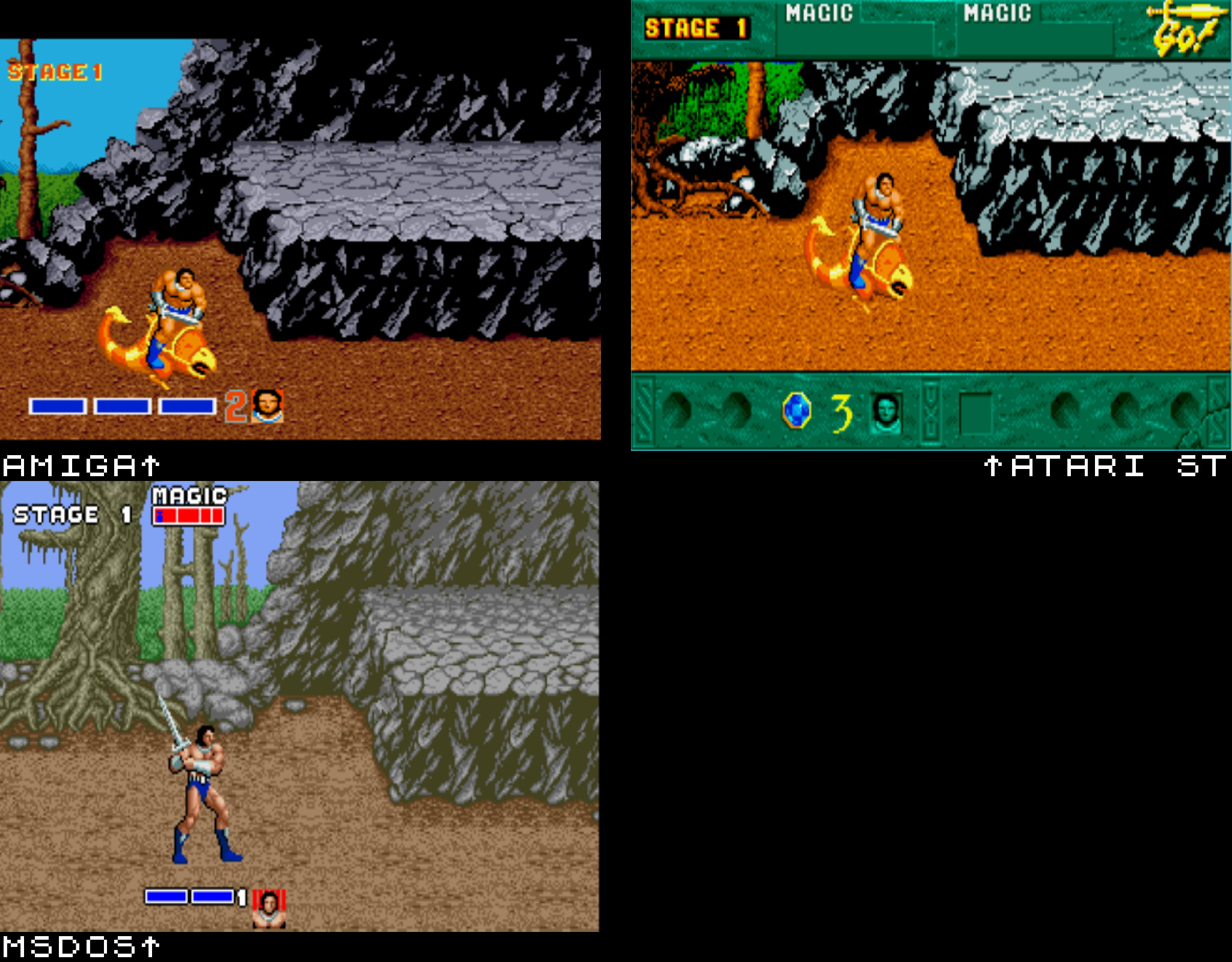](https://lemmy.world/pictrs/image/d21bd49f-a38d-4c28-902b-a0f7bf216867.png) There were, of course, ports released on more capable systems. The Amiga got a really good version. Clear, smooth graphics (albeit with quite sparse backgrounds at times) and an excellent soundtrack. In its initial release, it was let down by the limitations of a single button joystick (meaning jump was up and fire), but in this glimmering far future time, we're lucky enough to have the patched WHDLoad version, which allows for two button joysticks and makes the port much more enjoyable! Almost on par with the console versions, surprisingly. No such luck on the Atari ST, which suffers not only from one-button limitations, but also *everything else* limitations. It's kinda like the Amiga version but with worse sound (so far, so normal), and has the play area bounded by two large gaudy UI panels. Boo! The MSDOS port is okay, if a little *nimble* on my MiSTerFPGA emulation. It sounds good though, and the graphics are faithful. It did annoy me by demanding I produce a manual-based password before I could start the game... I had to find a forum post from 1995(!) to get around it (the password is probably AXE, if you're ever stuck like this!) [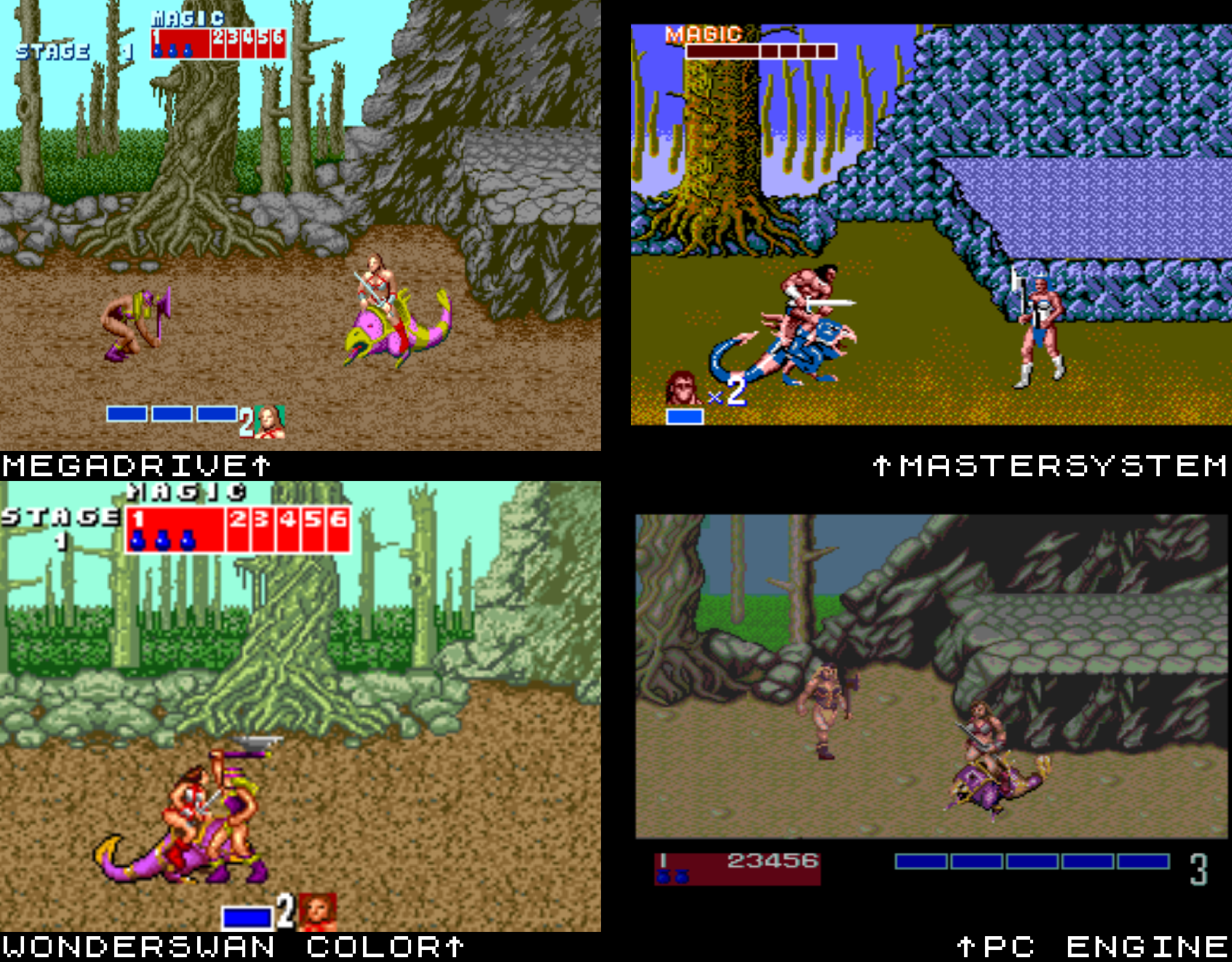](https://lemmy.world/pictrs/image/4eecf939-5a3e-4e2c-b208-d489a8d09b35.png) Finally, over on the consoles, the Megadrive port is the clear winner. It looks good (especially if you play the colour corrected version), and plays great. A quintessential early title for the system. The PCEngine CD is, surprisingly, terrible. With drab graphics, jerky movement, the whole thing is annoyingly generally janky. The Master System is better than it has any right to be. Very playable, but a bit jerky and only one playable character. The biggest surprise is the (checks notes) Wonderswan Color version. Tiny and faithful, a great port and well worth checking out, should be looking for something to play on your, um, Wonderswan Color. If you're going to play one, go with the Megadrive/Genesis version.

The first album I ever truly connected to... found when rummaging through my Dad's vinyl collection. I put it on on the strength of the cover alone, then listened to it endlessly for the next few year.

Ivan 'Ironman' Stewart's Super Off Road is a 1989 arcade release that plays kind of like a fancy Super Sprint. It's a single screen game where three players race their trucks over a number of courses, picking up nitro and money, and upgrading their vehicles between races. It's fast, goofy, chaotic and a lot of fun. The orginal arcade, notably, featured a three steering wheel cabinet. [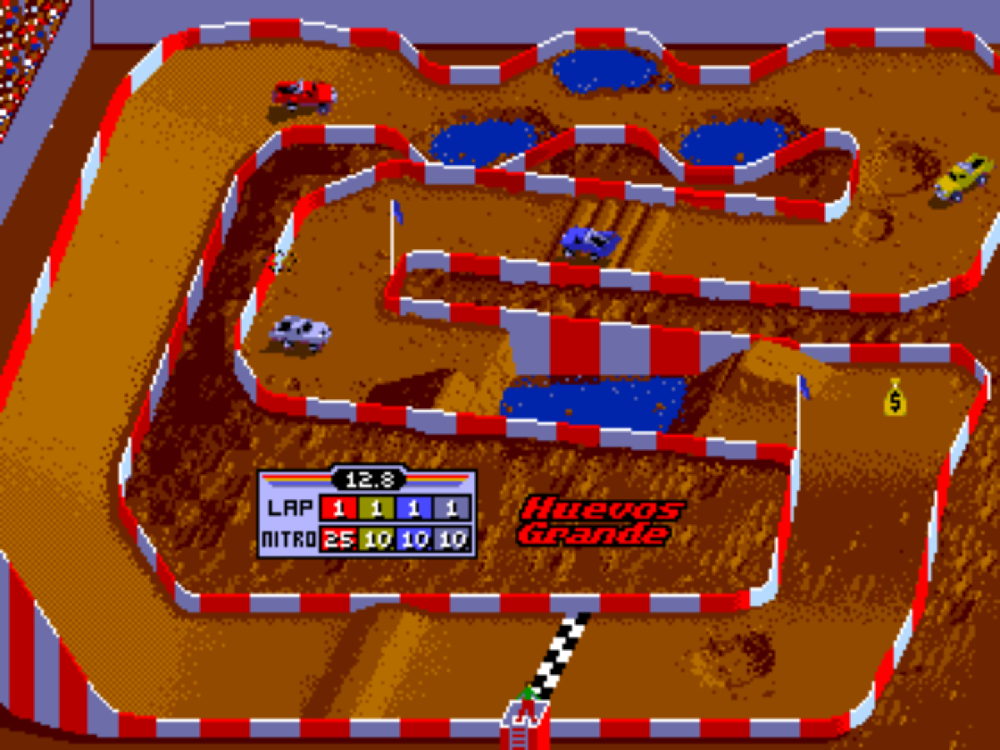](https://lemmy.world/pictrs/image/2db1745a-20c8-433c-9918-faee0881c836.png) On the face of it, this simple game looks ideal for home ports... but can they capture the mayhem of the original? The Amstrad CPC port is, unsurprisingly, based on the Spectrum version. But in this case, they've at least attempted to include some colour. Sadly, this amounts to changing the track to orange-brown and adding colour to two of the cars, meaning that the other two remain resolutely orange-brown. It's a curious choice, but I guess they ran into some four colour screen mode limit. It's not terrible though, but it does suffer from some horrendous slowdown. Like the Spectrum, it allows for just two players. Next up is the C64 version, and it's pretty good. It's more colourful than its 8-bit cousins, and it allows for up to three players. It moves and plays okay. But it feels a little bit stiffer, losing some of the chaotic speed of the original. Good attempt! The Spectrum port is arrestingly yellow. Yellow cars on a yellow track, with your yellow car being distinguished by a yellow square above your vehicle that takes a good few seconds to spot. However, despite its monochrome shortcomings, the conversion itself is top notch. As is often the case with Speccy ports, you can't hang your hat on either the graphics or the sound, but you will frequently find that the feel of the arcade original is captured surprisingly well. And that is totally the case here. Great speed, fluid control, a lot of fun! And some surprisingly good 128K sound! So, for the 8-bit micros at least (the only comparison that really matters) a Speccy win! For the posh kids, the Amiga got an effortlessly competent port. Lovely smooth graphics that perfectly capture the arcade original. Not much to say about this one, other than it's very good indeed. [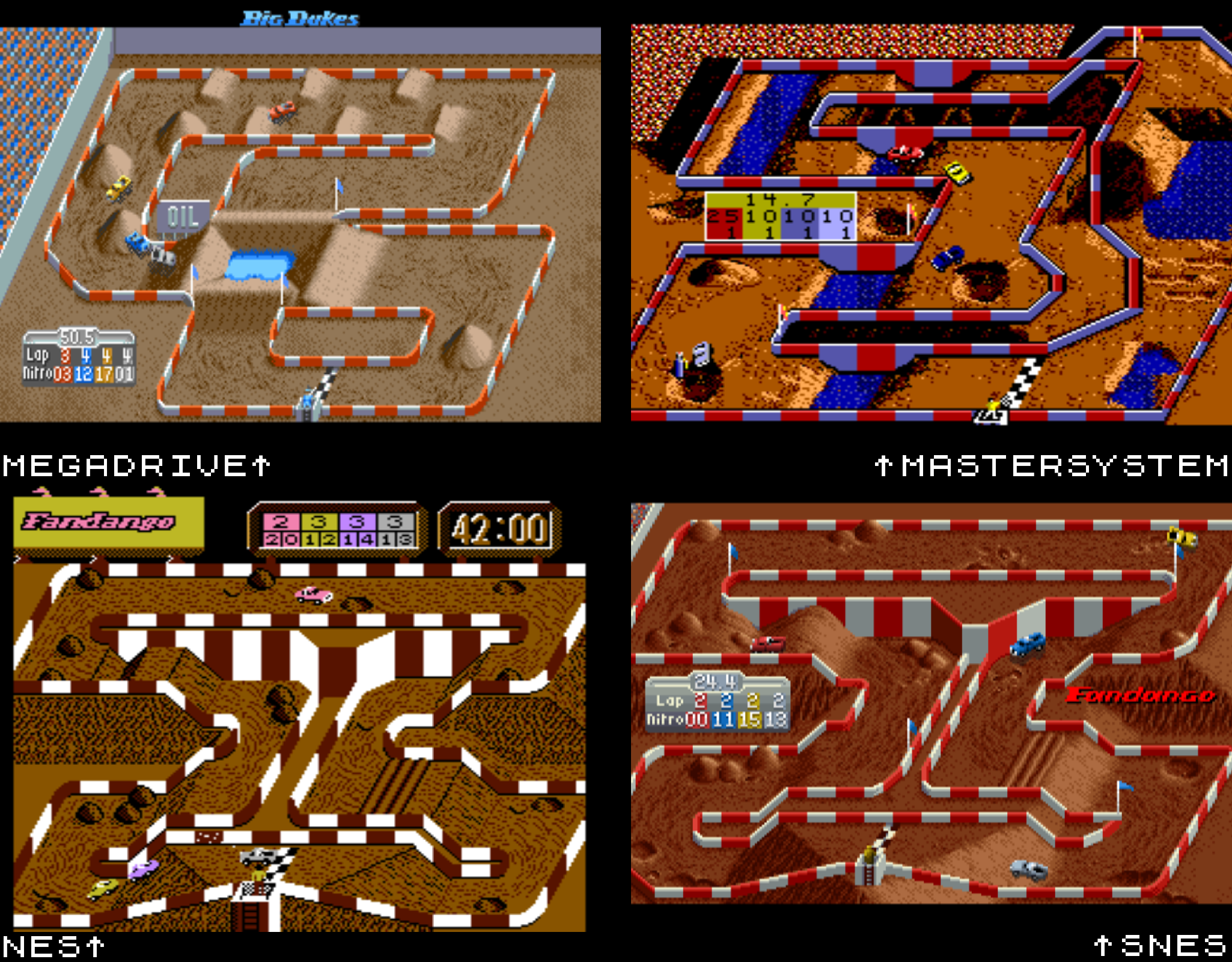](https://lemmy.world/pictrs/image/afc447b3-6241-4f70-ba77-31ada3cac78b.png) Over on the consoles, the SNES port is the best of the bunch. It looks, plays and sounds superb, retaining much of the original arcade and adding to it. Notably, the soundtrack is brilliant, with lots of catchy and memorable tracks. If you're going to play just one home port of Super Off Road, pick this one. It's rad! The Megadrive/Genesis port... not so much. It's not terrible, it just tries to add a uniquely Megadrive spin on the game, which doesn't quite work. The end result is a drab looking version with a crunchy/scratchy Megadrive soundtrack which doesn't play quite as well as the SNES version. On the 8-bit consoles, the Mastersystem is the best of the two. It's bright and crisp with good controls and smooth gameplay. The NES doesn't fare so well, with an incredibly drab palette that somehow swaps red for pink on the main car. However, it supports up to four players, which makes it unique among the home ports and even the arcade! [](https://lemmy.world/pictrs/image/c06100e6-c249-4ef9-bd76-152228370e12.png) Sadly, the handhelds don't fare so well. All of them lose the single screen in favour of a scrolling play area, which tends to make the game feel a bit claustrophobic. The best of them is the Game Gear version, which is basically the Mastersystem version on a small screen, and it plays almost as well. The Gameboy version, on the other hand, is a disaster, with slow scrolling, terrible controls and indistinct graphics. Kind of like a shitty RC Pro Am. And even worse than the Gameboy port, is the Atari Lynx port. It initially looks promising, with chunky, colourful graphics that capture the arcade well. Then it starts moving... jerky scrolling, bad controls and annoying sound make this the very bottom of the bunch. Avoid!
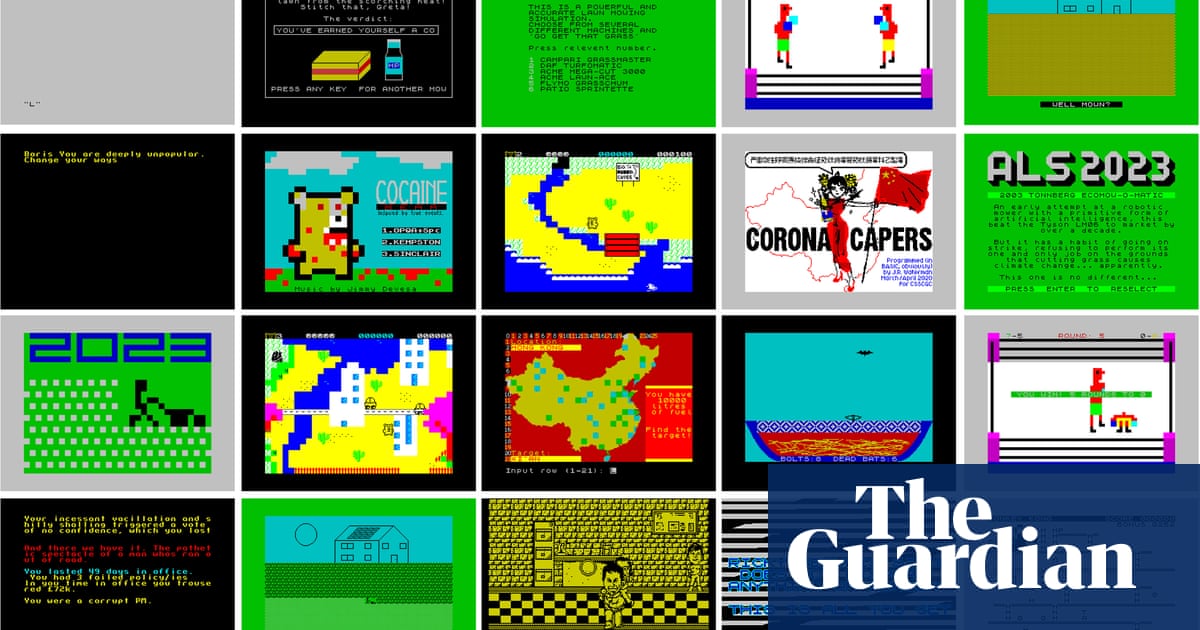 www.theguardian.com
www.theguardian.com
... a version of which is somehow still running to this day!

R-Type is the greatest game ever made, right? Right? No? Then get off my land, you pervert. It just is. The 8-bit ports of the game were mixed: the Amstrad got a terrible, slow, drab port. The C64 got a fun shooter that felt loosely based on the source, but which loses points for straight up doing it's own thing (as the C64 often did). But it's the ZX Spectrum port that really shines. More colourful than it had right to be, fast, faithful, fun. It was a weird kind of miracle: so accurate you could even use your arcade learnings to do well at the game. So, for the 8-bit micros at least, clear Speccy win! ... But they were, all of them, deceived, for there was another 8-bit computer R-Type made. 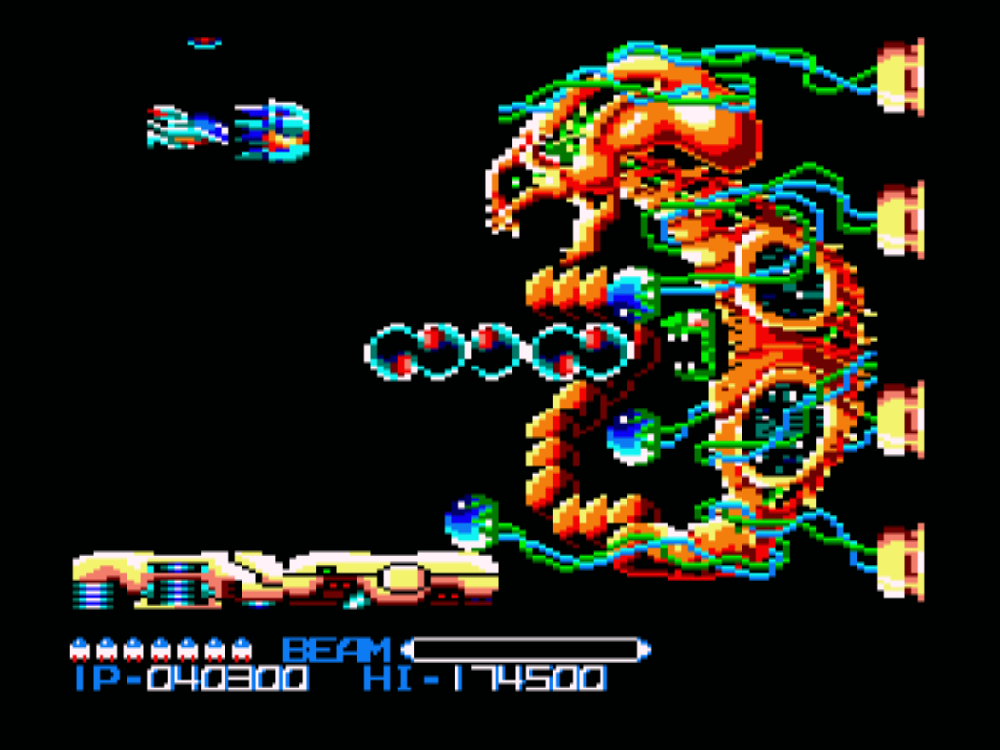 On the internet, in the coding forums, homebrew coders forged in secret an Amstrad port to beat all the others. And into this port they poured colour, accuracy, music... And the result is pretty great. Amazing to see what the Amstrad can really do when it isn't getting stinky Spectrum ports. I would say this one ties with the Spectrum port for playability.

I'd struggle to place the year, probably 1983 or early 1984, but the first game I ever played on our first ZX Spectrum was "Maze Death Race". 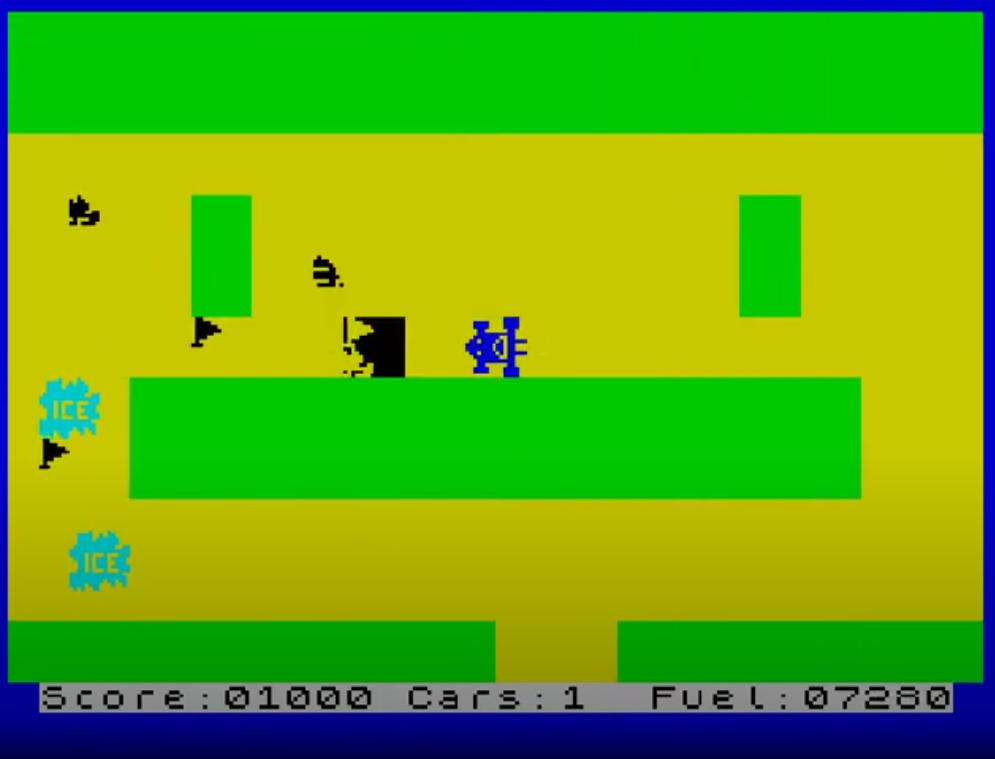 It was a blatant Rally-X rip-off, from a time when intellectual property rights felt more like guidelines than actual rules. You move around a maze, collecting flags, avoiding other cars and oil patches. You can select the speed of the other cars, and that's about it. Most of all, I remember it being janky as anything. The graphics felt like they were falling apart, with UDGs flashing in and out of coherence, jerky movement, blurping sound effects... But I had no frame of reference, no point of comparison. To my 8 year old self, the mere fact that a recognisable car was moving around on our TV under my control was mind-blowing. I honestly had no idea that the glitchy graphics were anything other than purposeful - that instability seemed to add to the allure somehow. It felt like a window into a weird world I'd only had hints of before then... And that cassette inlay art... nowadays it looks amateurish; back then it was the coolest thing I'd ever seen!

A shameless bit of self-promotion. It's 3 years since I got it into my head that I wanted to make a Spectrum game. I'd done BASIC in my salad days, but never machine code... How hard could it be? I picked the ancient 1982 arcade game The Pit, which had never been ported to the Speccy and looked like a good fit. Here's the original: https://www.youtube.com/watch?v=mTIjYc-ZH-A I spent a month drowning in ASM, but finally finished it... and here is what I came up with: https://youtu.be/YQeyKqAeEaY?t=128 https://dokdave.itch.io/the-pit My main goal, as well as learning machine code, was to get it as close as possible to the arcade - not easy given the Spectrum's limitations. Luckily, The Pit helped me out - its colour scheme is basically the Speccy palette. It is based on 8x8 blocks, like the Speccy. It's horizontal res was similar as well. Only the vertical res was challenging. In the end, I settled on having the screen flip between top and bottom, rather than be single screen. But it seems to work fine. The most rewarding part of the project was focusing on the fine details - the weird title screen, the font, the high-score and instruction text. And the biggest challenge was actually making the gameplay feel like the arcade. Not easy when you're terrible at the game and can barely finish the first cavern. Oh, and, of course, machine code... Honestly, it feels a bit like a fever dream. It's so different from the modern programming languages I'm used to. Needing to think of memory as something you actually need to care about and consider is so alien to me. No variables, as such; self-modifying code; considering how quickly you can get a new screen generated and copied to the "TV"... By the end of it, I was thinking in t-states and frames and little else. It's all gone now, of course, lost in a whirlwind of pandemic and other distractions. I doubt I could remember a tenth of the things I learned in that month... But maybe I'll get the urge one day and dust off the old assembler again. Maybe I'll wonder anew at how the hell bedroom coders did it back in the 80s, without the convenience of modern IDEs, debugging and such. As a nice bookend to this project, later that year I opened my copy of the Crash 2020 Annual and found this... 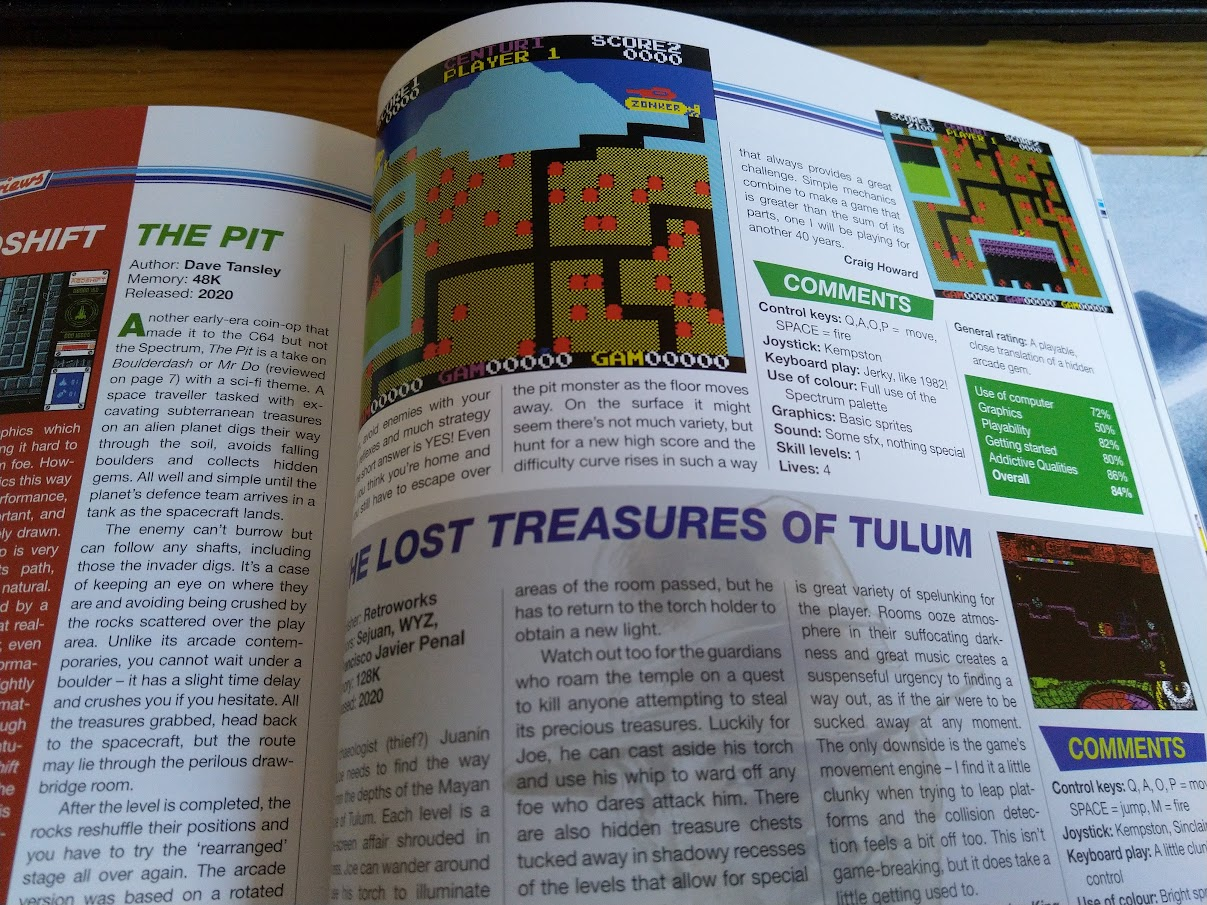 My fanboy scream probably registered on seismographs!

Buggy Boy (Speed Buggy in the US) feels like a game that deserves to be remembered more fondly. Sadly, it always seems to fall through the cracks between the likes of Outrun, Power Drift and Chase HQ. This is a shame, because it is a fun little racer that received some mostly decent 8-bit ports on the #Amstrad, #C64 and #Spectrum. But which one was the Buggy-est Boy of all? Step this way... 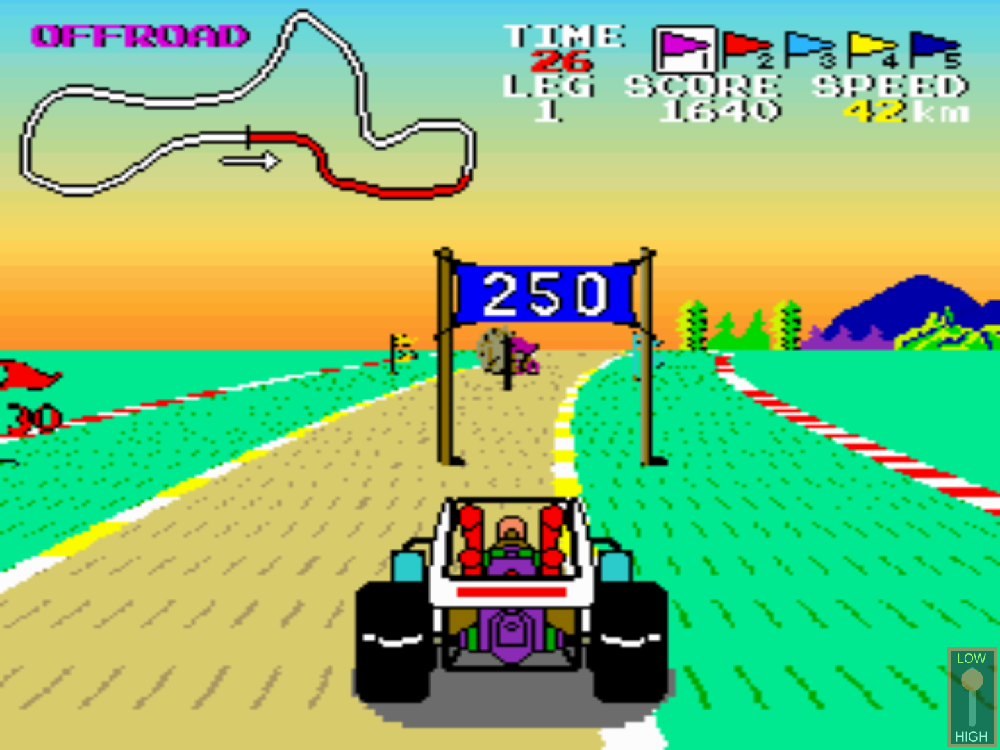 In the arcade, Buggy Boy is probably best remembered for its cockpit version with a panoramic three-screen display. There's also an upright, single-screen version, called Buggy Boy Jr, which is basically the same game. In Buggy Boy, you race five tracks, collecting flags for points and time, and avoiding boulders and water traps. There are jumps and objects that flip you up onto two wheels. You'll see other buggies, but the game is mostly a race against the clock. It's a lot of colourful fun! 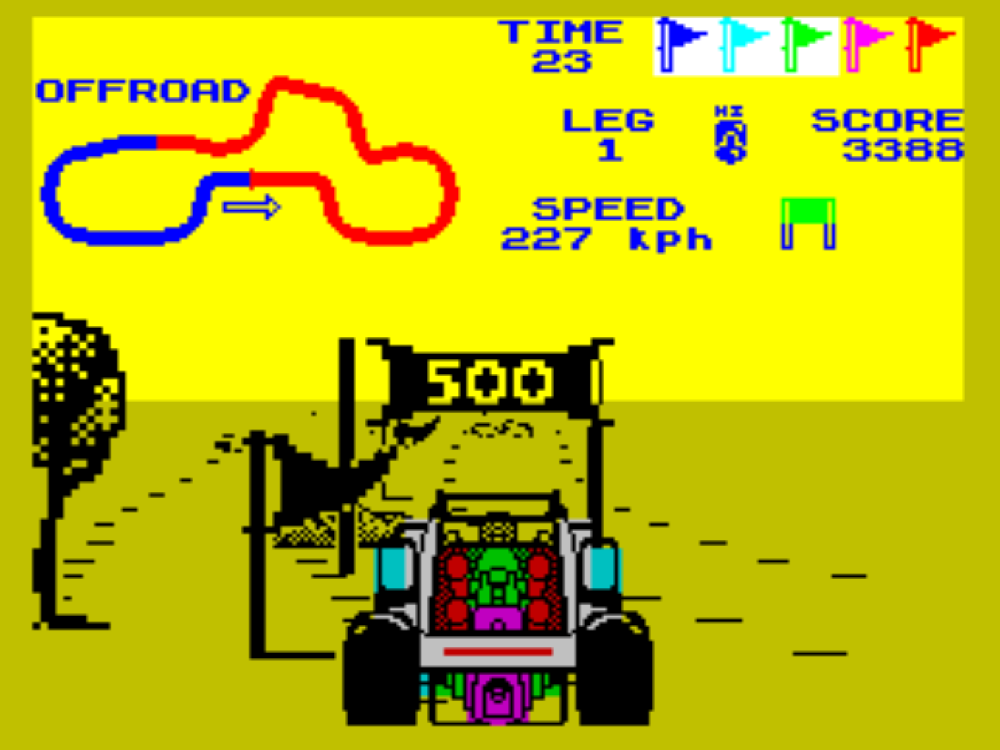 First port we'll look at is the Spectrum port. It's very different from the other two, and makes a plucky attempt at recreating the arcade faithfully. It has a valiant attempt at a huge buggy sprite, with colour no less, which moves about okay-ish. And the road has hills, just like the arcade. Unfortunately, just because you can do something, doesn't mean you should. The huge sprite makes the road feel very cramped, and the gameplay feels slow and indistinct. Good effort though! 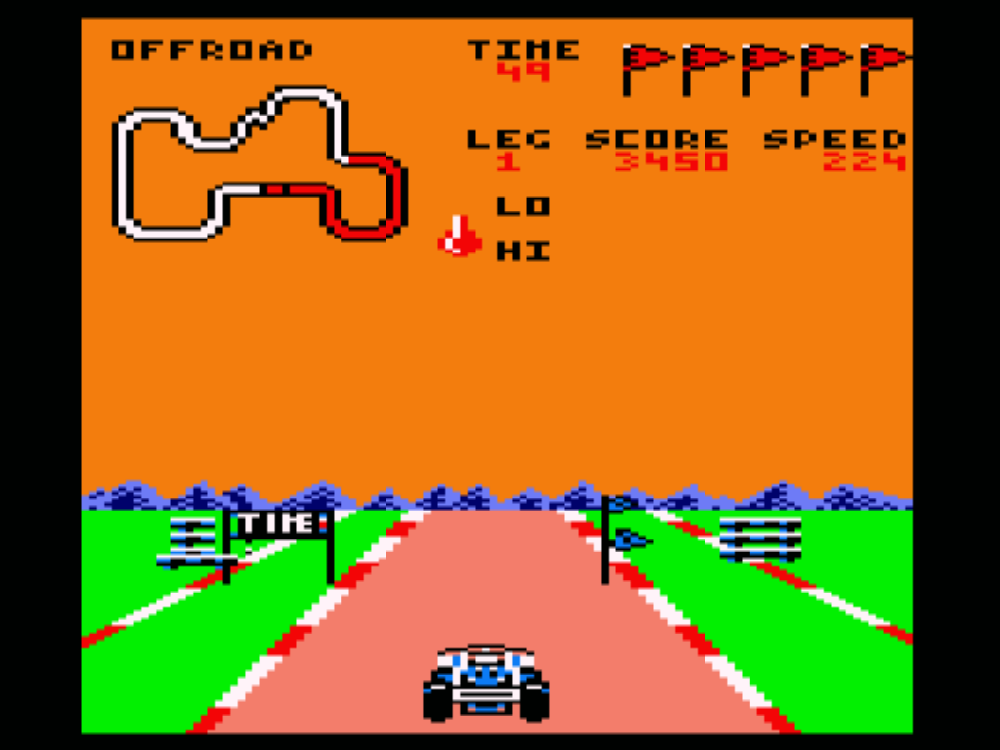 Next up is the Amstrad. Like the C64 port, this feels more like it was inspired by Buggy Boy, rather than faithfully ported. Unlike the Spectrum, the buggy sprite is tiny. This actually works in the game's favour, keeping it snappy and responsive. The road moves nicely, albeit with no hills, and overall it's an enjoyable, if slightly slow, experience. 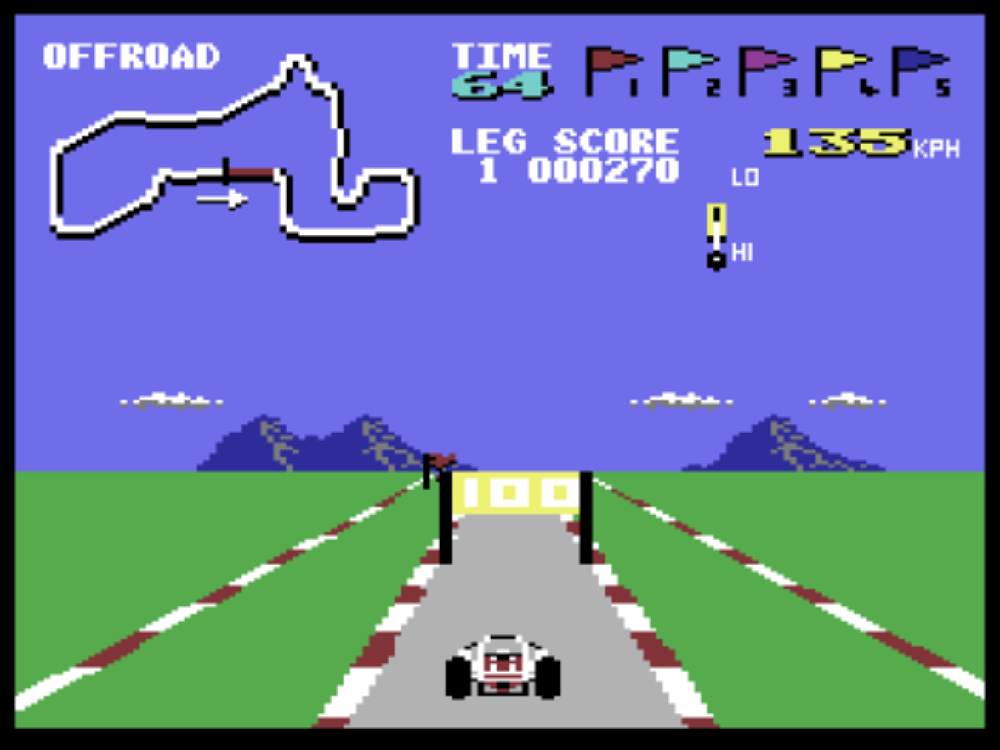 Best of all is the C64 version. This does everything the Amstrad does, only better. The same presentation (making me wonder if the Amstrad was ported from this), same small sprite, same nimble gameplay. But this version moves better and is a lot more fun to play. Getting to the next checkpoint is hugely compelling and it plays like a great, simple racer. If you had to nitpick (Spectrum guys always have to nitpick the C64, right?) you might say that it is a little drab... but never enough to detract from the game. A very clear C64 win!

The first RPG I ever played! This book has so much nostalgia for me... first watching the cool kids over the road playing it and picking up a White Dwarf to see what it was about, then finally getting in on a game and getting my own copy of the rules. 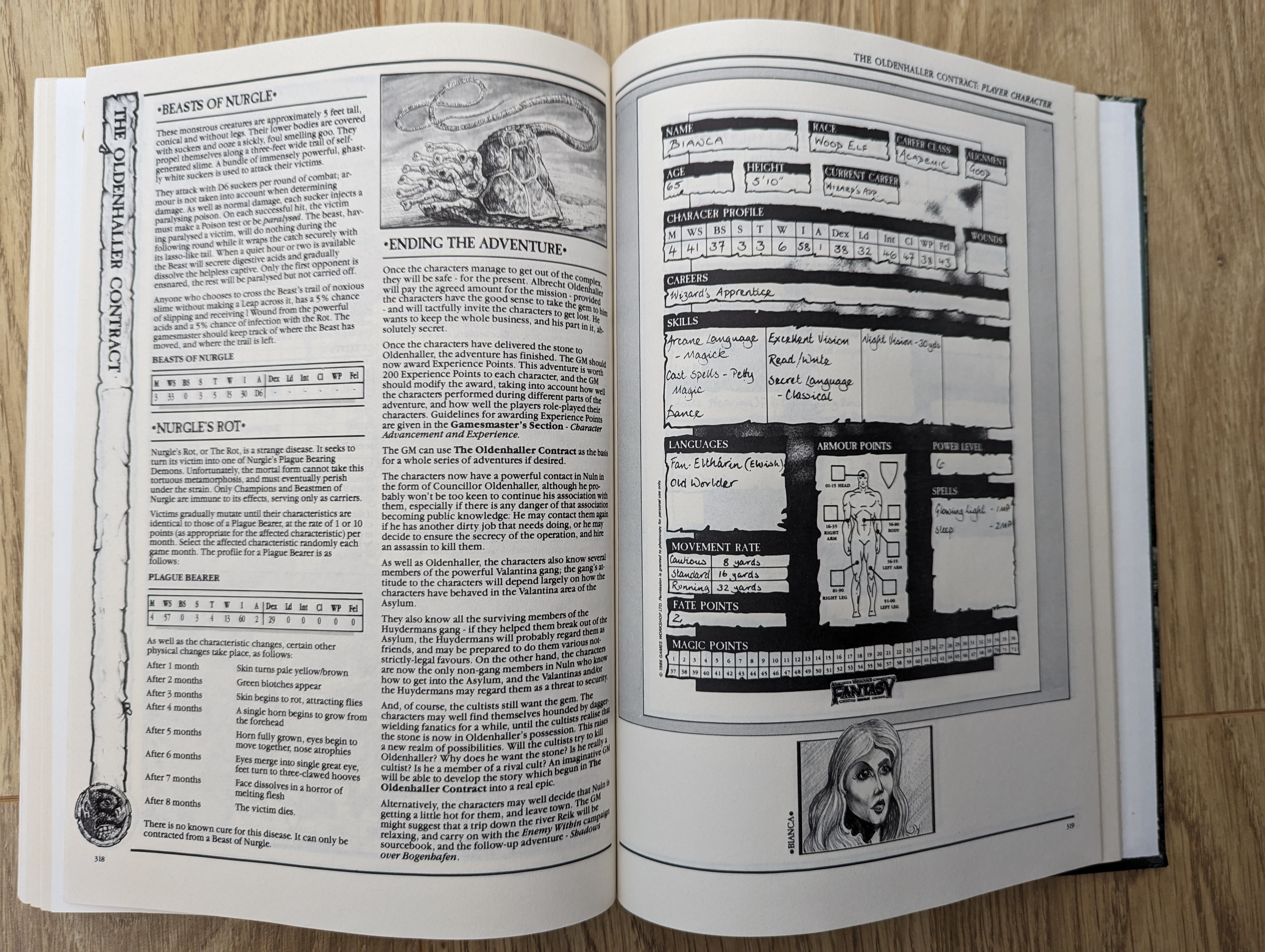 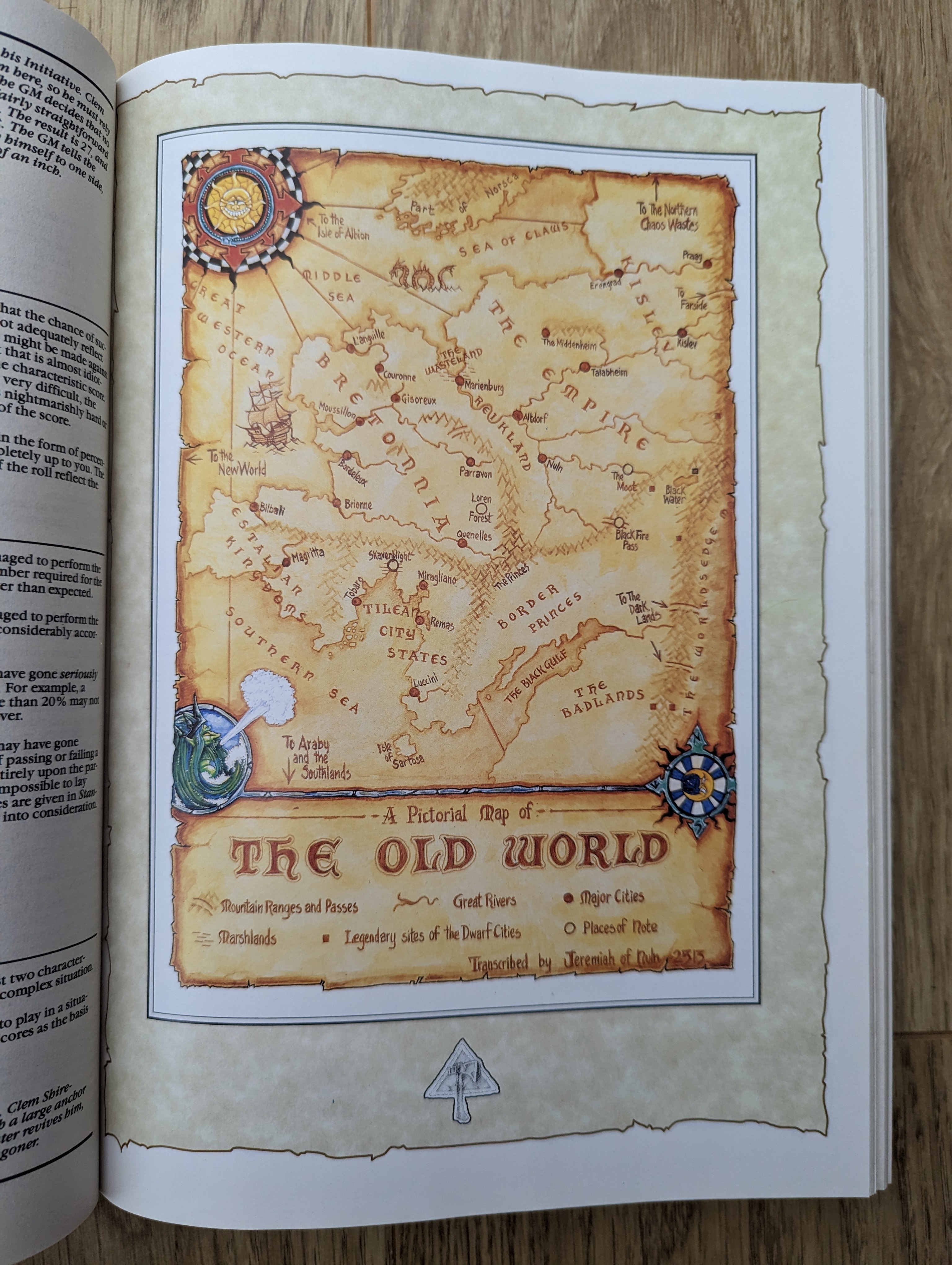

Green Beret is a difficult game to love, because Green Beret is a difficult game to play. Honestly, it's brutal. Utterly unforgiving, unfair in places, and generally infuriating. Especially since every life lost is greeted by a shrill siren sound that will have even the most understanding spouse reaching for her earbuds (trust me).  It's also a simple game, if a little rooted in the concerns of the 80s... move to the right, murder fools with your knife and your deep fear of communist expansion, pick up the occasional flame thrower or rocket launch to murder more efficiently... win!!! But how did the home computer conversions handle the absurd difficulty of the coin-op? They'd have toned it down, right? Right??  **Amstrad:** This port is the worst of the three main ones. There's just something off about it. Maybe it's the loose controls or the insane difficulty, or maybe it's the fact that your green beret looks more like Robin Hood and the communist aggressors look more like merry men. Still, everything from the arcade is represented here. Just not brilliantly. And it is so so difficult...  **Spectrum:** Next up is the Spectrum. It's a port by the late great Jonathan "Joffa" Smith and it is a really neat conversion. The graphics are bright and crisp, it controls and moves around well, and it feels like the original arcade. But goddamn it's hard. I had to figure out how to use a Multiface, just so that I could poke in a cheat and get to my screenshot spot for this one!  **C64:** The C64 port is probably the best of the bunch, but not by a long way. It looks and sounds great, definitely the closest to the arcade. It's main problem - believe it or not - is difficulty. Again, it is insanely hard. And it suffers from some unfair hit box issues - if you jump and collide with an enemy on a level above, you lose a life, which feels wrong.  **Atari:** Finally, a dishonourable discharge for the Atari 8-bit version which is, frankly, a bit of a war crime. It's beyond hard and enters an entirely different realm of frustration, with your hero wielding the smallest knife imaginable and enemies requiring the intimate closeness of a secret lover before they'll shuffle off this mortal coil Combine this with invisible bullets (pesky Russian tech) and that awful siren that plays at the start of EVERY life and it's a recipe for an 800XL out the window.

My first love was the ZX Spectrum, but my first salacious affair was with the Sega Master System, many years later. It was a time in the UK when consoles were hardly even a thing. We'd somehow missed the NES wave that was gripping the US, and we were still clinging to our 8-bit micros or the new 16-bit STs and Amigas. No-one seemed particularly keen to swap £1.99 budget cassettes for £29.99 cartridges. So, getting the Sega Master System was both extremely exciting and also a tacit acceptance that new games would arrive a couple of times a year, rather than every few weeks. And it was totally worth it. To my naive 14 year old mind, the games were basically arcade perfect... Of course, this was a measure of my own lack of exposure to actual arcades, rather than the port quality itself. But the games were definitely more polished than the Speccy games I was used to. As such, I have extremely rosy memories of virtually every game I found a way to play. Sometimes unjustly. Like, for example, Psycho Fox by Vic Tokai. Psycho Fox is a side scrolling platformer where you play the eponymous fox, but also a range of other animals with different abilities. You run to the left, jump on enemies to kill them, fight a boss every three levels... so it's just like Super Mario Bros, right? Well, that's how I remember it. It was Sega's Mario, and in my mind it was just as good. Of course, I hadn't played Super Mario Bros at the time, and it would be years before I played Sonic. As such, I had no real frame of reference to judge Psycho Fox's strengths and, more importantly, weaknesses... Because Psycho Fox has a fatal flaw which means we live in a world dominated by Sonic and Mario, rather than a crow-throwing fox... Movement. There's just something off about the movement in this game. The acceleration curve is too shallow, it takes forever to get moving. As such, jumps always require a run up, and escaping from enemies can feel like wading through treacle. 90% of the deaths you'll suffer are because you can't get up enough speed fast enough. And it is extremely frustrating. It's a shame, because it's otherwise a great game. It has a Sonic-esque blue-sky feel to it, the character work is awesome, and the extra animals add an interesting dimension to how you play the game (Tiger can move fast, Monkey can jump high etc). The range of levels is interesting and includes the usual tropes (desert world, ice world with slippery momentum) and the boss fights have some novel quirks. Overall, it's definitely worth a look. But to truly enjoy it, you will need to unlearn all of the instincts you've build up from more fluid Sonic and Mario games. You need to think about every jump, and really take your time. What about you? Did you play Psycho Fox back then? Have you played it since? Did it hold up for you?


